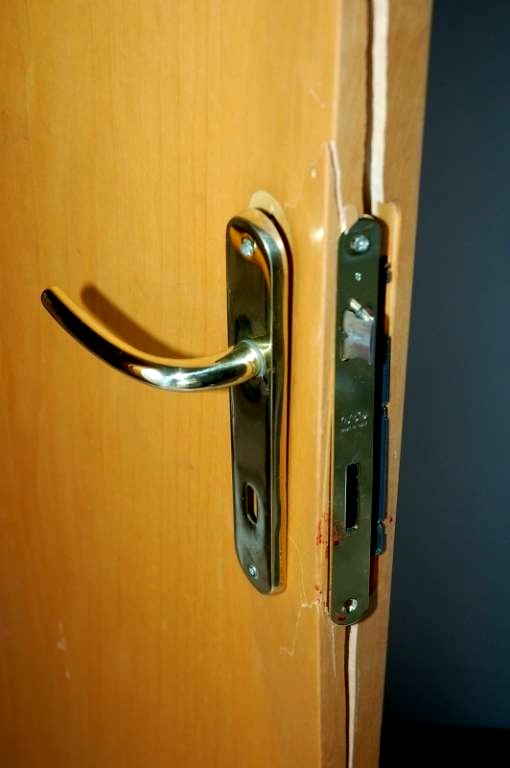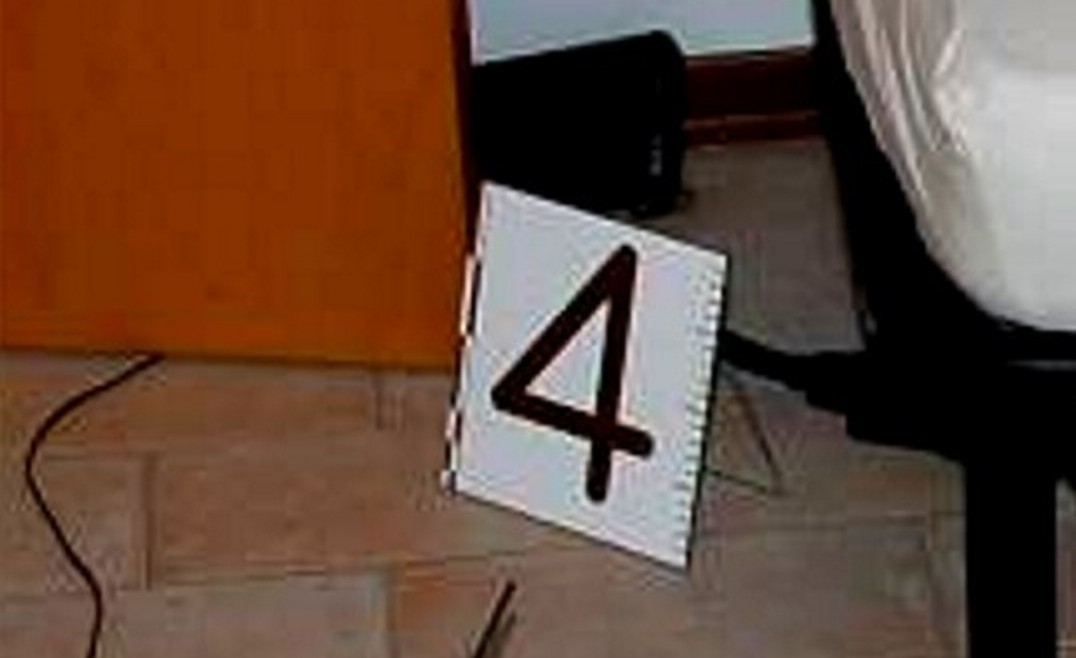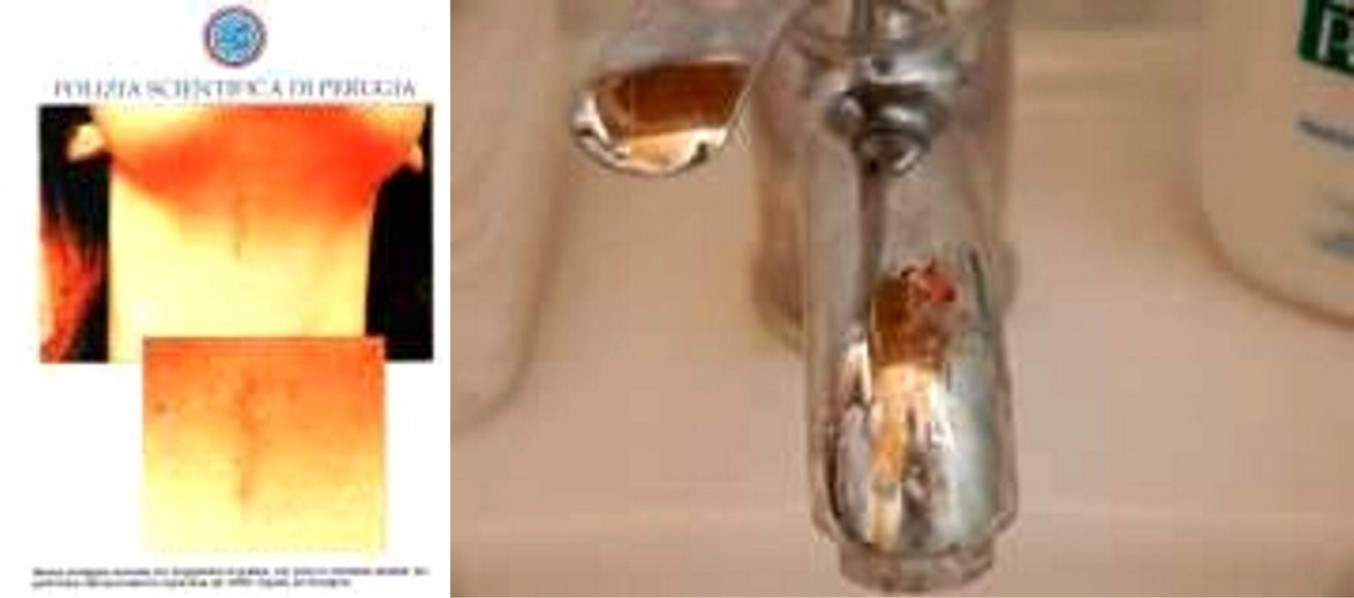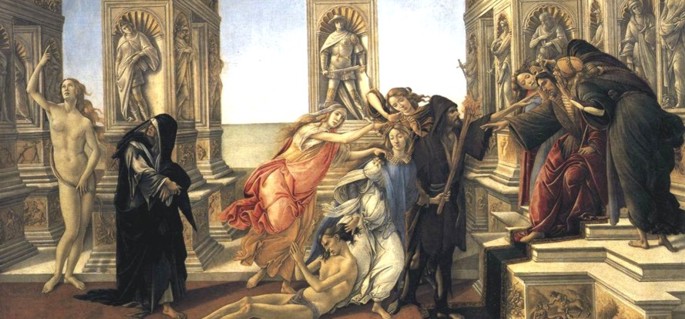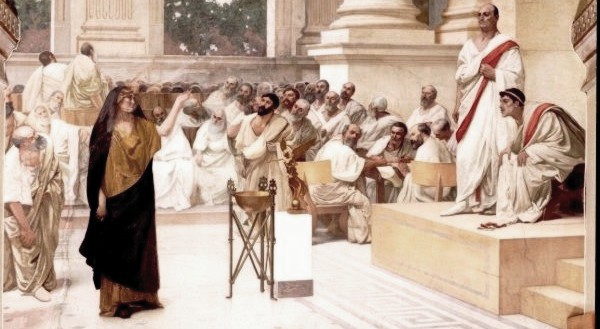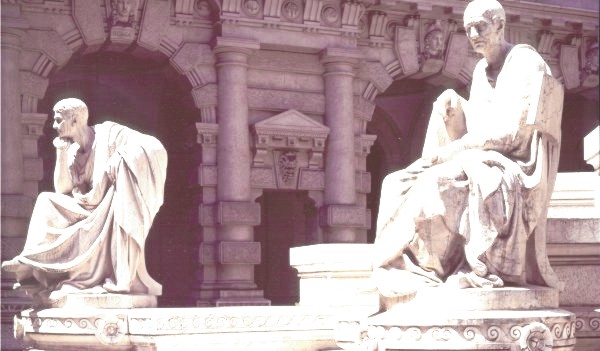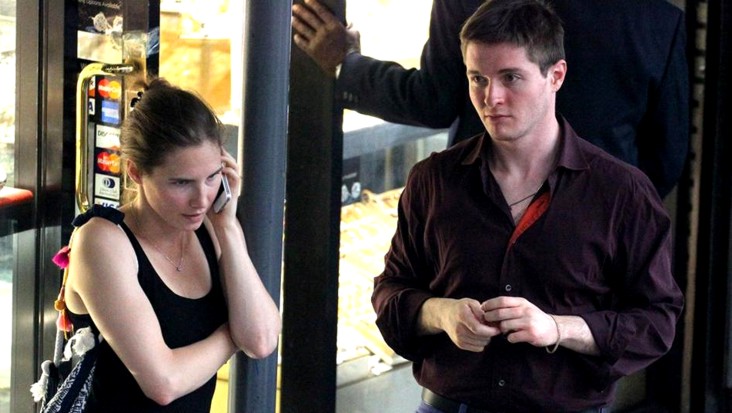
Headsup: Disney's Hulu - mafia tool?! First warning already sent to the Knox series production team about the hoaxes and mafia connections. The Daily Beast's badly duped Grace Harrington calls it "the true story of Knox’s wrongful conviction of the murder of her roommate". Harrington should google "rocco sollecito" for why Italians hesitate to talk freely.
Wednesday, July 24, 2013
How The Clean-Up And The Locked Door Contribute To The Very Strong Case For Guilt
Posted by James Raper
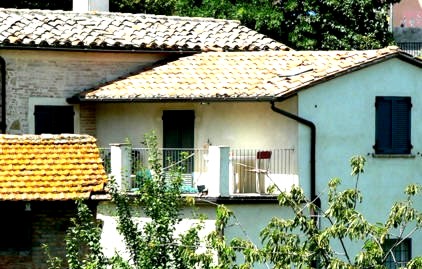
On the 30th September the appeals of Amanda Knox and Raffele Sollecito against the convictions they received at the first instance trial will resume, this time in Florence.
This follows the annulment by the Supreme Court of the acquittal verdicts rendered by the Appeal Court presided over by Judge Pratillo Hellmann. There is one conviction not under appeal. This is Knox’s conviction for calunnia, which is now definite.
They are therefore both currently convicted of murder and sexual assault, and a number of lesser charges, amongst which there is the simulation of a burglary “to ensure impunity for themselves from the felonies of murder and sexual assault, attempting to attribute the responsibility for them to persons unknown who penetrated the apartment to this end”.
There is one activity, for which there is evidence, with which they were not charged (perhaps either because it was redundant or not a criminal offence) though this was likewise to ensure impunity for themselves.
This is the partial clean up at the cottage and it is this with which I intend to deal. I want to highlight salient observations which have been under discussion here and elsewhere and some of which may be well known to readers, but perhaps some not, or have been forgotten about. Once again, in many cases, I am merely a conduit for the observations of others, not least the first instance trial judge Giancarlo Massei.
So let”˜s consider the observations and in doing so we can also throw some more light on the lone wolf theory.
1. Take a look at the bloody footprint
This is, of course, the bloody footprint on the bathmat in the small bathroom right next to Meredith’s room.
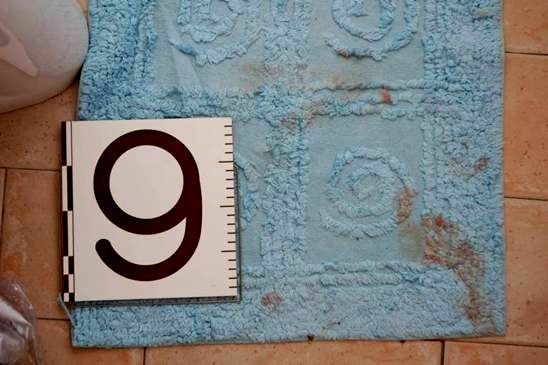
The heel of the right foot, if it had blood on it, is missing from where it should be on the tiled floor. It is difficult to imagine, given that the imprint of the foot on the mat is contiguous with the edge of the mat, that there was not at least some blood on the remainder of the foot such that there must have been at least some blood deposited on the floor.
Just as difficult to imagine that casual shuffling about on the bathmat would have removed the blood so as to render it “invisible” to the use of luminol.
Of equal relevance is that there were no connecting bloody footprints. Why not?
The defences have an improbable theory - that Guede, despite his homicidal rage, was smart enough to hop about on his left foot with a clean shoe on, and the other bare but covered in blood, and that having by this means entered the bathroom and washed his bloody right foot, disastrously leaving his (supposed) imprint there in the process, he then returned to Meredith’s bedroom inadvertently standing in blood with his left shoe and leaving with a trail of bloody left shoe prints - in which case the exercise of washing his foot was entirely in vain, on two counts, after all that careful hopping around.
Neither is it entirely clear why his right shoe came off in the first place.
It is far more probable that the inevitable bloody prints were deliberately and carefully removed. The reason for doing this was not just to conceal who would have made them (the print on the bathmat was, after all, left in situ) but, from a visual perspective, to conceal any blood that might be noticeable and alarming to anyone approaching Meredith’s room. Guede’s bloody shoeprints in the corridor were visible but only on close inspection.
2. Take a look at the bathroom door
Specifically the internal (hinge) side of the bathroom door. Take a look at this photograph.
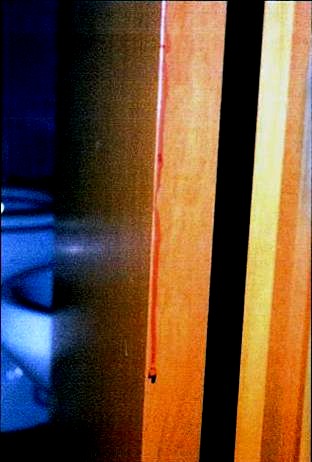
We see a long streak of dried blood. Clearly the blood has flowed some distance under the influence of gravity and we can see that it looks slightly diluted, with red corpuscles gathering towards the tip of the streak. A drip of that size does not appear from nowhere.
Indeed it is difficult to imagine how the blood got there unless it was part of a larger area of blood which most likely was on the face of the door and which was swiped to the right and over the edge of the face of the door. The cloth or towel used to do this was wet accounting for the slight dilution and length of the streak.
3. Take a look at Meredith’s door
It is interesting, is it not, that there is blood on the inside but not on the outside? The outside:
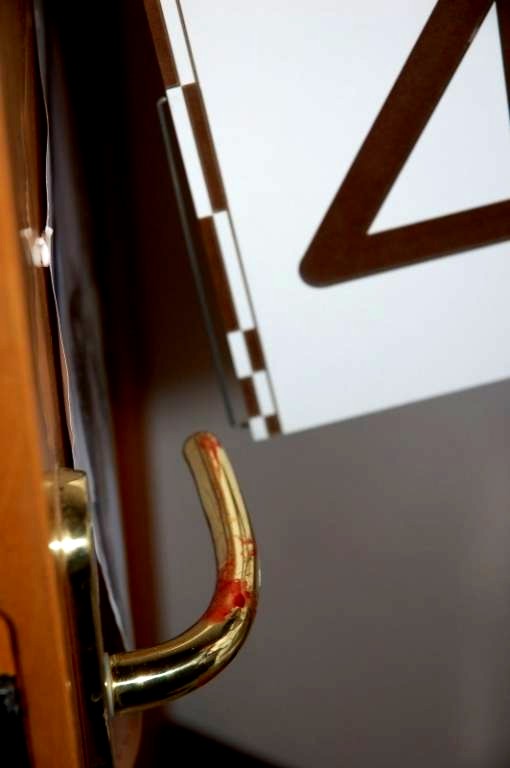
It is difficult to see how and why Guede touched the inside handle with a bloody hand (was it shut and if so, why?) and then closed the door to lock it without leaving a trace on the outside face of the door. Possibly he might have changed hands. The answer might also be that he visited the bathroom to wash his hand as well as his foot, save that none of his DNA was recovered from the spots and streaks of diluted blood in the washbasin, whereas Knox’s DNA was. All the more surprising given that Guede shed his DNA in Meredith’s room.
We see some blood on the edge of the door which again might be the remnant of a trace on the outside face.
4. Take a look at Amanda Knox’s lamp.
This was found inside Meredith’s room behind the door. Meredith also had a similar lamp which was resting on it’s base on the floor by her bedside table.
The presence and location of Knox’s lamp is obviously suspicious. Had Meredith borrowed Amanda’s lamp because her own was not working, then it would not have been in the position it was found but on or more likely knocked over and lying beside the bedside table since the violence appears to have been concentrated in that area of the room.
Had Meredith’s lamp been on the bedside table then likewise it too would most likely have been knocked over in her life and death struggle with her sole assailant (there are blood streaks on the wall just above) and it would not have ended up sitting upright on it’s base.
Both lamps were probably used to check the floor of Meredith’s room after the event and Knox’s lamp was probably sitting upright until it was knocked over by the door being forced open.
This is Meredith’s lamp by the bedside table.
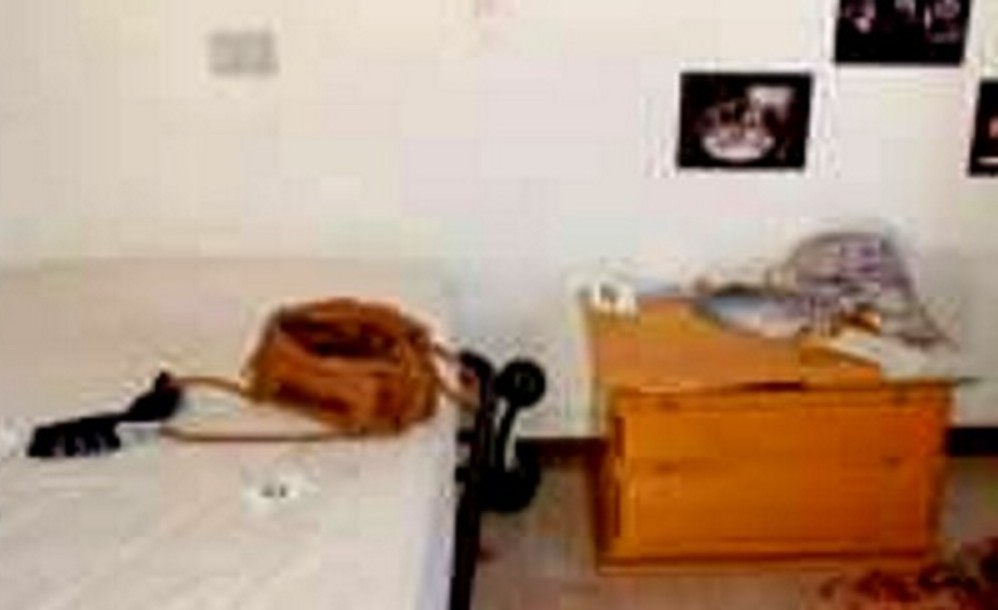
And this is Knox’s lamp by the foot of the bed.
5. Take a look at what luminol revealed
We can state with confidence that luminol (extremely sensitive to and typically used to identify blood that has been wiped or washed away) discovered :-
(a) three bare footprint attributable to Knox, one in her bedroom and two in the corridor, and
(b) two instances of the mixed DNA of Meredith and Knox, one in Filomena’s bedroom and one in the corridor.
(c) a footprint attributed to Sollecito in the corridor.
I have covered a number of elements strongly suggesting that there was at least a partial clean up, not of “invisible DNA” as the Groupies like to mock, but of what would have probably in some cases have been noticeable deposits of blood that would have attracted the eye of anyone entering the cottage and which would certainly have alarmed the observer as being difficult to explain.
Spots of and footprints in blood, not just in the bathroom but outside it, a locked bedroom door with blood on it, and a bathroom door with blood on it’s face.
We can include Knox as one such observer given her e-mail account of having allegedly stopped by the cottage to have a shower and collect some clothing before the discovery of the body. Such physical evidence - had it not been removed - would not have sat easy with that account, however dizzy and naïve Knox presents herself. One can envisage Knox thinking “sorted” - that her story would now work perfectly.
Even so, there were elements that were overlooked, such as Knox’s blood on the washbasin faucet and blood generally in the small bathroom, but a door can be closed and at least these were elements amenable to some form of explanation from her perspective, whether or not convincing, as occurred in the e-mail.
Incidentally in addition to the mixed traces in the small bathroom, Meredith’s blood was found on the light switch and a cotton bud box. I have a hard time imagining what Guede would have wanted with the cotton bud box, less so Amanda given her blood on the faucet, ear piercings and a scratch on her throat. Knox, when asked during her trial, could not recall having switched on the light during her alleged visit to the cottage.
6. Take a look at the items on Knox’s bed
Massei concluded that it was likely that it was Knox who carried out the clean up, which if correct might explain why it was not central to her thinking to dispose of the bathmat with Sollecito’s bloody footprint on it!
Knox was seen by Quintavalle at his store at 7.45 am on the 2nd November, thereby destroying her alibi. He described her as pale faced, exhausted looking, with pale blue eyes. He also added, and he would not have known this from photographs in the newspapers, that she was wearing blue jeans, a grey coat and a scarf, with a hat or cap of some sort.
We can see from the crime scene picture of Knox’s bedroom below, that such items (minus hat or cap) appear to be lying on her bed.
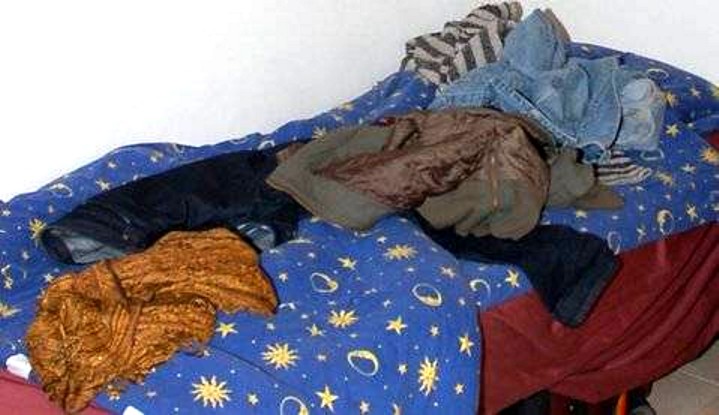
Sollecito did not accompany Knox to the store but this would be because he was known to Quintavalle whereas he was unfamiliar with her. He may however have accompanied Knox to the cottage and/or have acted as look out for her when she was there.
7. Some conclusions
I have included “The locked room” in the title because of a poster’s observation regarding Guede’s bloody left shoeprints exiting Meredith’s room. There is the simple observation that these footprints are going one way only and not towards the small bathroom. But they do not even turn to face Meredith’s door, and again hard to imagine that this could be so if it was Guede who locked her door!
We can rule out Guede as having been involved in any aspect of the clean up precisely because of that trail of footprints and other evidence of his presence left behind.
Now that the travesty of the Hellmann acquittals has been truly exposed Knox and Sollecito face an impossible uphill task.
The clean up and the locked door are just two of many elements in this case which combine together and corroborate each other in a manner that enables us to see the truth beyond a reasonable doubt.
Thursday, July 11, 2013
Fast Forwarding And Minimalizing Demanded By Cassation Could See Appeal Conclude This Year
Posted by Peter Quennell
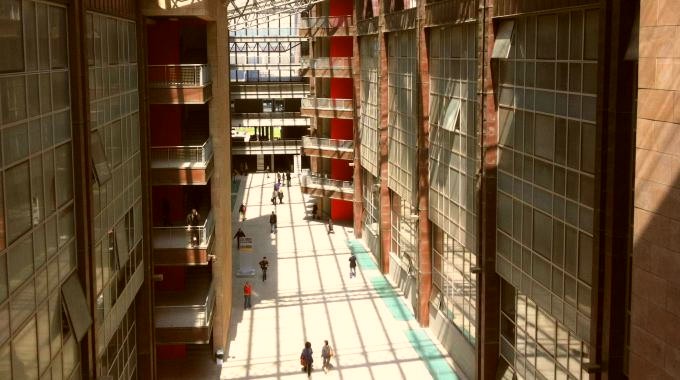
[Above: the interior atrium of the new Florence Palace of Justice]
We posted below on Florence’s probable new chief prosecutor, the formidable Dr Spataro.
The new attorney general for Tuscany, Dr Tindari Baglione, is also said to be formidably unbending. He will select the prosecutors for the appeal. The selection of judges is unlikely to follow the murky precedent of Perugia’s humiliated Chief Judge Di Nunzio in appointing what Cassation considered to be two incompetents.
One of the many dirty tricks involved Giulia Bongiorno’s new baby. She asked for plenty of time to attend to it, which humanized her, and the 2011 appeal court met on average only every 3-4 weeks. This allowed the PR to build to a crescendo over the better part of a year.
Also it placed the Kerchers at a huge disadvantage as they get no financial help to attend. The 2011 jury saw them just once face to face - after the verdict had been “decided”.
We wont see a replay of that farce in Florence. Weekly meetings of the court are expected, and with this fast-forwarding and the instructions of Cassation to minimize the scope, the verdict should be arrived at by the end of this year, or only very shortly thereafter.
Cassation could endorse the final outcome as soon as next spring or summer.
Well prior to this playing out, the investigations into the contempt of court by RS and AK in their ill-advised books will be completed, and new charges against both of them and their publishers and key capos in their entourages seem rather certain, as well as against Oggi.
If RS and AK fail to attend the opening session of the appeal court they would not neccessarily be charged additionally, but they could be ordered back to prison for the duration of the appeal and arrest warrants could be issued,
If there is a real case to be made for either of them not attending we have not seen it. But their books pretty well rule out any exposure to cross-examination on the stand.
Wednesday, July 10, 2013
Appeal Starts 30 Sept: Why This Man Could Stop Defense Dirty Tricks In Their Tracks
Posted by Peter Quennell
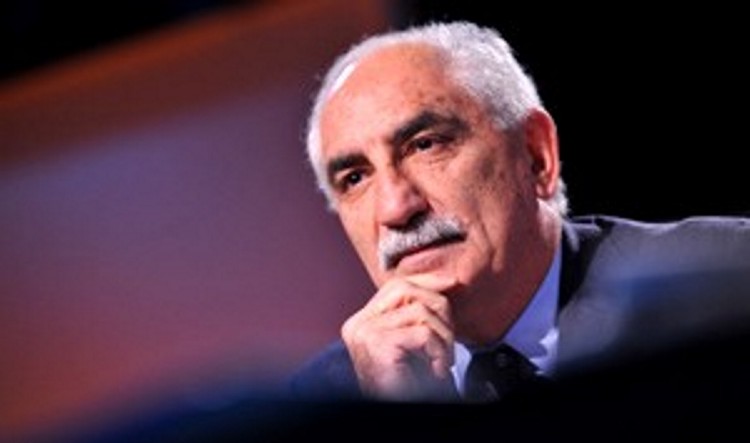
Deputy Chief Prosecutor Armando Spataro.in Milan is one of the toughest prosecutors in Italy.
In September Florence’s current chief prosecutor Giuseppe Quattrocchi will retire - and Dr Spataro is considered to be the frontrunner to take his place.
The Florence prosecution team is being made even more formidably tough these days because it has some very high-profile cases involving national politicians and corruption on its hands.
Read Yummi’s detailed post of 21 January which explains much of this context - and why Florence will be very averse to the dirty tricks the Knox-Sollecito defenses and their allies were able to pull in Perugia.
Florence was the jurisdiction where a rogue prosecutor and a rogue judge sentenced Dr Mignini for what Cassation scathingly declared were fully legal actions, when it recently killed a trumped-up case against him and Dr Michele Giuttari stone dead - and opened the way to Dr Mignini being the next chief prosecutor in Perugia.
Dr Spataro will be especially formidable against Knox and Sollecito and their army of shoot-themselves-in-the-foot defamers because he has stood up to strong Italian government and American government pressures before. Our September 2009 post explained:
Italy’s a tough country with, albeit dwindling now, a legacy of violent crime, and many brave prosecutors over the years have been assassinated.
And the Italian legal system is not particularly weighted in their direction, with a large number of hurdles they have to climb over before a case ever gets to trial.
And the Italian prison system is relatively lenient, heavily pro-prisoner-remediation and early release, and proportionally only 1/10 the size of the US’s.
So the endemic attempts to undermine Prosecutor Mignini have invariably won only MORE popular support for him and his case in Perugia and Italy in general.
And the only “criminal charge” against him (it isn’t) seems to flow from his guessing right in the Monster of Florence case - and apparently no charge of this kind has ever won a “conviction”.
Above is Milan Deputy Chief Prosecutor Armando Spataro. He is in the news now because he has demanded prison sentences for TWENTY-SIX Americans.
Between them they seem to have colluded in grabbing Osama Moustafa Hassan Nasr, an Egyptian in Italy, back in President Bush’s day, and taking him off to be tortured.
Not to the United States where torture is not legal, but to Egypt where it more-or-less is.
Human rights advocates charge that renditions were the CIA’s way to outsource the torture of prisoners to countries where it was practiced.
The CIA has declined to comment on the Italian case, and all the Americans are being tried in absentia and are considered fugitives.
As we remarked in [another] post it is pretty hard for a foreign government and especially now the American government to throw sand in the Italian wheels of justice.
ut
The American government is really just sitting this one out. And it may be covertly delighted when Amanda Knox and her clan fade to silence.
Dr Spataro went on to win that case against the 26. Although their extradition is not yet being pushed,-for, the State Department sided with Italy and gave them no immunity.
State was even sued over that, but good Italy-America relations were deemed important enough to come first.
Saturday, July 06, 2013
Crazed Rant Against Judge Massei Expected to Hurt Prospects For Both Sollecito And Knox
Posted by Peter Quennell
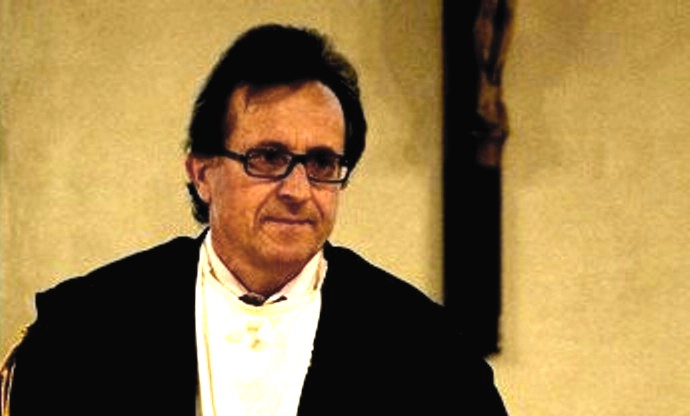
This is what we are hearing from informed readers in Perugia on the rant we translated for the post below.
It is believed that neither RS’s father nor his lawyers nor the Knox people have any control now over him. He is right now quite a loose canon, and very close to finding himself entirely on his own.
There is widespread outrage at the attack on Judge Massei (image above) who is known as a kindly and courteous man, and a very good judge. Correctly understood, he gave the two quite a break in 2009 with the “mitigating factors” and placing of the main blame on Rudy Guede.
Judge Massei knows about this attack and it appears he will take action against it. It is expected to result in further consequences for Sollecito. The attack seems unprecedented in the US and UK as well as in Italy.
The attack seems more evidence of the contempt of the court for which Sollecito is already under investigation in Florence by the SAME chief prosecutor who will organize the prosecution team for the re-run of the appeal. It almost makes inevitable that Cassation’s hard line will be reflected in the outcome of that appeal.
As to what inspired it, Sollecito is universally regarded locally as a wimp, a weak character, who was under Knox’s control during the attack on Meredith she organized, and has been outshone by her since. (His book actually says this in places.) In the crisis that is the Cassation ruling, he wants to show her above all that he has a personality, and thinks that insulting the judiciary is the way to prove it.
Thumbing his nose at Knox? Macho strutting to win her back?
Knox is said to be under very tight control, so presumably we wont be getting her take on it any time soon.
Wednesday, July 03, 2013
Questions For Sollecito: Did Your Father & Lawyers Pre-Approve This Rant?
Posted by Our Main Posters
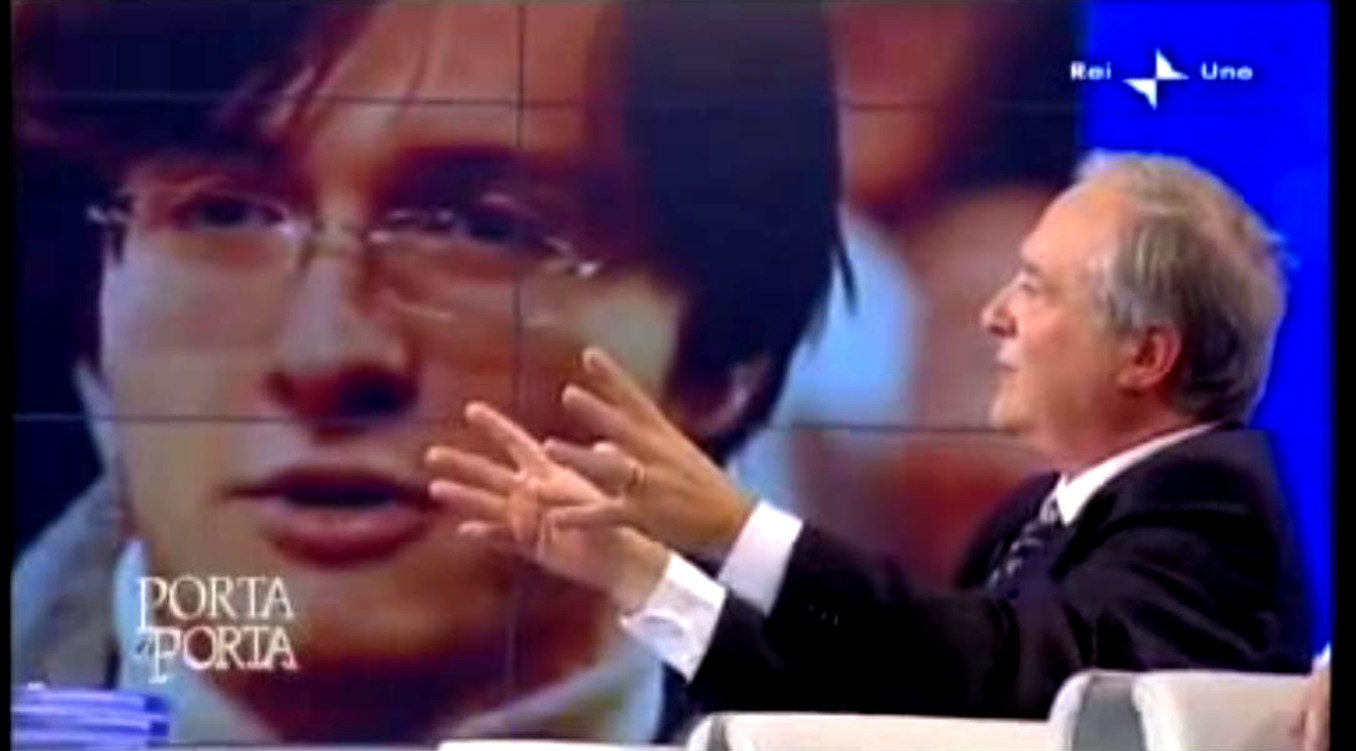
[Francesco Sollecito previously on Italian national TV trying to explain the weirdness of his son]
This is in response to your open letter to Italy’s TGCom website.
You are starting to sound eerily like the serial killer Ted Bundy in jubilant “catch me if you can” mode. Ted Bundy also thought he was the brightest guy on the block and the cops, prosecutors and judges were all a few bricks short of a wall.
Ted Bundy was of course caught, by smart cops, and put on trial, by smart prosecutors in front of a smart judge and jury. He made a terrible hash of his defence, he was unanimously found guilty, by a jury of smart peers, and he was made to pay his dues to society and the victims’ families - with his life.
You posted this to an audience in Italy which for the most part thoroughly dislikes you, when you are already in line for sentences that could cost you 30 years ranging up to life.
So. Did your father Francesco and your lawyers Bongiorno and Maori (and all of Knox’s people) give you the go-ahead for this seriously bizarre rant, or not?
Once upon a time, there was Amanda and Raffaele, she was an American student, studying languages and he studying Computer Science. They met at a classical concert and fell in love… no wait like that it is too boring….Lets make it more intriguing, lets see…..I know!
The prosecution found a crazy drunk, and cocaine dealer, Kokomani, after a year the story becomes: Amanda and Raffaele met in August, no one knows how or when, and one day at a bar, where Kokomani would get drunk, Amanda’s uncle came from America, no one knows why or when, and introduces the fiancees ( about to get married, I would say at this point) to the ignorant (unknown) Kokmani (who maybe thought he was going to be the best man) it’s clear. UNDERLINING that he is Amanda’s uncle and the two young people are Amanda and Raffaele (famous at the time, after all)
Mmmm…...come on it’s not the best, but at least it is more interesting, it doesn’t matter that there is no confirmation to none of this, anyway it’s a movie, OK. let’ s continue…..
Raffaele rents a house on Corso Garibaldi, a five minute walk from Via della Pergola, where Amanda lives with three roommates, Meredith, Filomena and Laura. The two pass many days together, they cuddle, have fun, they have outings to towns close to Perugia, and a couple of times they have lunch at Amanda’s house with the other flatmates. They live enthusiastic days, smiling every time they look in each others eyes….. Halloween Day, Oct. 31 2007, Amanda goes to work at Patrick Lumumba’s pub, so Raffaele works on his thesis and late that night they meet up….. to be together as always, taking care of each other.
Uff! What a pain in the ass! Give this movie a bit of adrenaline, what the hell! O.K. O.K…...one day along comes a heroin addicted serial super witness brought by the prosecution who says that he saw Amanda and Raffaele in Piazza Grimana, by a small villa a few feet from via della Pergola, discussing vividly, no one knows what and no one knows what day, but it happened at 9:00p.m. to 11:00p.m. circa. It doesn’t matter that the night between the end of Oct. and beginning of Nov. was freezing cold, it doesn’t matter that Raffaele has a house where he can do what the hell he wants, but according to the heroin addicted serial super witness, the two were under the rain for three hours (if we are talking about Nov. 1, 2007) and the cold discussing who knows what, furthermore, the heroin addicted serial super witness of murders (who’s name is Curatolo) says that when he went back to Piazza Grimana the two contentious fiancees were no longer there and he saw the buses that go to the discos boarding the kids…..it doesn’t matter that the 1st of Nov. there is not a bus in this world because the night at the disco was on the night of Halloween, Oct.31, 2007…...for the Pubblico Ministero Giuliano Mignini, Curatolo was a credible witness. Even because heroin does not produce hallucinations while cannabis does.
In reality the two fiancees passed the evening and the night at Raffaeles’s house since it was free and they had an intensive week of commitments. The 1st of Nov. in particularly Amanda had to work at Patrick’s pub, but as the evening was not busy he did not need Amanda, and after a friend of Raffaele’s passed by to cancel an appointment to go to the bus station, suddenly the two fiancees had the night free and they passed the time watching the movie “il favoloso mondo di Ameliè”, then eating fish Amanda read Harry Potter in German to Raffaele and they made love all night…...
Il Giudice di Primo Grado, Giancarlo Massei took in full the version of the heroin addicted serial super witness tramp….. Come on Giancarlo we are still not satisfied! Come on! These two fiancees are cramming our balls!! You are all of us….
According to the reconstruction of Judge Giancarlo Massei, that sentenced Amanda and Raffaele to 25 and 26 years in prison, things went this way: Amanda and Raffaele after being 3 hours in the cold under the rain, the night of the 1st of November 2007, head toward Amanda’s house in Pergola street and go right away into Amanda’s room (a room that was smaller than Raffaele’s cell when he was in prison) and start making love to bother Meredith who was reading a book in the other room…doesn’t matter that more than 5 people had car trouble and were waiting for a tow-truck, in front of the house during that time, and they give testimony that nobody passed by
Sorry, but why didn’t Amanda and Raffaele go to Raffaele’s house that was free and nobody would have been bothered?.. . Come-on! Why do you have to take into consideration this useless details, show us some firecrackers! Go Giancarlo!
Judge Massei continues: sometime during the evening, while the two were having sex in Amanda’s room, suddenly somebody knocked at the door… Amanda and gets up and gets dressed goes to the door and who does she see? ...Rudy Guede, a colored guy that didn’t know anybody except the guys of the lower floor and had met Amanda and Meredith one time but never in his life had he met Raffaele,. that urgently needed to take a shit.
But what?! What kind of plot is this? Where in the hell do you see that people go around knocking on doors because they need to take a shit?... Come on Giancarlo do not disappoint us! But judge Massei does not disappoint us…. Meanwhile Amanda opens the door to the poor black, victim of bewitched charm for Amanda, and goes inside to go to take a shit…. and Amanda as if nothing happen, goes back in the room and gets undressed again…
But why couldn’t Meredith go open the door while she was reading a book?..Oh, right! Otherwise Amanda loose the part of the main actress, sorry, you are right!
Practically , according to Judge Giancarlo Massei’s reconstruction the story goes on like this : while Amanda and Raffaele went back to have sex, Rudy Guede comes out of the bathroom, after listening to some songs on his ipod, he is overwhelmed by the SEXUAL VIBRATIONS that Amanda and Raffaele were relishing in the house hallway and the house room….
WTF Giancarlo, this is tough shit! Not even Dario Argento could come up with something like that…. “SEXUAL VIBRATIONS”....WTF you are a genius!! Give me five!...but the good part has still to come: when Guedé smells the SEXUAL VIBRATIONS, all of a sudden he is possessed and decides by all means that he has to have sexual intercourse with Meredith.. and ventures in her room and, being rejected, because poor soul he is ugly, Raffaele and Amanda get into the action and at that point dont help Meredith who is their friend, but, to the contrary and unexpectedly, they help Rudy Guede to rape Meredith and than finish her up cutting her throat…
All three had knives: Rudy has a past as thief, he used to burglarize offices and apartments with the same “modus operandi” that he used to get in in via della Pergola, moreover he has been captured while sleeping in a kindergarten in Milano with a knife in his bag. Raffaele had always a little collector knife in his pocket: never mind that he never used it to hurt anybody in his life, there are no traces of anybody else on his little knife “¦.Amanda… and Amanda? Judge Massei says that she used an enormous kitchen knife got from the “looser” Raffaele’s house and put it in her purse…. why?? because…YOU NEVER KNOW (a 15 cm knife can be always useful “¦).. Massei says.
But the poor Meredith was a small build girl, her wounds are not that big and that knife would have gone through the neck because of how big it is… there isn’t blood on that knife nor Meredith’s DNA because the analysis of the scientific police are completely unreliable , not having being compelled to observe the international protocols. There are no bleach traces. What the police says are hypothesis never proved .
Come on, details! But there are no traces of Amanda and Raffaele on the crime scene, there are only Guede’s, everywhere. How it is possible that they were cleaned, were are the traces of the cleaning??! Come on do not break our nuts! This is just details, let me see this movie!
What about that little bra hook? There are 5 different profiles…all on the iron part of the hook, nothing on the tissue: it has been found 46 days after the “polizia scientifica” swept the crime scene, and meanwhile even the police swept the scene with no anti-contamination precautions and put upside down the all apartment. There isn’t Raffaele profile on that hook: if that mix of traces is properly read you can find anybody’s DNA
Do you want to stop with these bothersome things?!! Lets finish to see this movie!! Massei concludes: we don’t know why Amanda and Raffaele choose to kill Meredith, but we have to accept their choice. THE EVIL CHOICE. Probably under the influence, because they didn’t despise her, taking into account that they said that they smoked a joint… unfortunately nobody tested to check if Amanda and Raffaele used heavy drugs or were in the habit of binge drinking. WTF! Great job! You weld The Exorcist and Lethal Weapon!! Giancarlo you are my idol!!!!
Friday, June 28, 2013
Updating Our Scenarios And Timelines #2: An Integrated Comparison Of The Timing of the Phone-Events
Posted by Cardiol MD
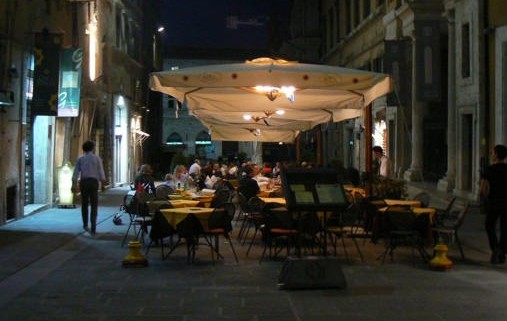
[Above and below: what Meredith missed, outside dining in Perugia at night]
1. Point of our series
TMJK’s core focus has long been upon “What happened at 7 Via della Pergola, in Perugia, on the night of November 1-2, 2007?”
Over the last 4+ years, more than 20 TJMK posts, with more than 400 comments, have addressed the subject of possible scenarios and timelines for those events. They represent a lot of thought and many are worth reading if you haven’t come across them before.
This post is the second in a series that will reappraise the more probable speculations, using the current state of our information. The first post was four weeks ago.
Reader comments in response to Part 1 amply reflect readers’ interest in exploring the various “˜open Questions’ referred-to, and how efforts to make Knox and Sollecito confront the true answers are obfuscated by their falsehoods.
The Truth of the actions of Knox and Sollecito on November 1st & 2nd, 2007, is so precious to them that they attend that Truth with a “˜Bodyguard of Lies’, to borrow Winston Churchill’s famous WW11 dictum. They even further obfuscate the answers to our questions by selectively employing a Bodyguard of Actual Truths.
The aim of their broken drain-pipe under the sink story (see previous post) was to persuade investigators, and everyone else:
1. That there was a broken drain-pipe under the sink (Massei Translation p.67), and
2. That the alleged water-leak occurred BEFORE the murder.
Their obfuscations include:
1. The omission of references to incriminating truths, e.g. omission of references to the hammer-toe on RS’s right-foot, one of his most incriminating physical attributes (see representative image of a right-foot hammer-toe below), and
2. The inclusion of “Half” truths, and
3. The inclusion of references to non-incriminating truths.
2. Integrated timing of phone events
This post is an integrated comparison of the timing of the phone-events byy coordinated universal time, merging Massei’s sections on Amanda Knox [AKP], and Meredith Kercher [MKP], as well as that of Rafaelle Sollecito [RSP].
[For the day of 31.10.07 it was shown that Meredith’s mobile phone with service provider Vodafone 348-4673711 sent an SMS at 18:27:50 hours using the cell at Piazza Lupattelli sector 7. (this signal is received in Via della Pergola 7.)
The same number received an SMS at 18:29:05 hours (this exchange of messages took place with the number 388-8921724) connecting to the same cell.
[RSP]: − on 31.10.07 Raffaele received *a call+ from the father’s fixed line (No. 080-3958602) at 22:14 for 44 seconds.
With respect to Sollecito’s mobile phone 340-3574303, attention was paid to the entire day of 1.11.07 with the following results]
Which help establish a less-suspicious baseline for comparison with later, more-suspicious results.
[RSP]− 00:00:39 an outgoing call, just after midnight
The phone traffic with regard to the day of 1.11.07 was reconstructed in the following terms (cfr. statement of Assistant Stefano Sisani at the hearing of 20.3.09).
AKP− 00:41:49 hours: outgoing phone call of 20 seconds, to a number whose holder was not identified
RSP− on 1.11.07 *he+ called the father’s house at 00:02:41 for 262 seconds
AKP− 00:57:20: Amanda’s mobile phone sent an SMS, using the cell on Via dell’Aquila 5-Torre dell’Acquedotto sector 3 (which does not provide coverage to Sollecito’s house, since it pertains to Via Ulisse Rocchi, Piazza Cavallotti, etc. and therefore at the heart of Perugia’s historic center). This consisted of the SMS which the young woman exchanged with Raffaele at the end of the Halloween evening to arrange meeting up with her boyfriend and be accompanied home
RSP− 00:57 an incoming SMS 319
AKP− 1:04:58: Amanda’s mobile phone received *a call+ for 53 seconds from the number 075/9660789, located in Piazza Danti 26
RSP− 14:25 an incoming call which lasted 58 seconds
RSP− 16:50 an incoming call, coming from the mobile phone of the father, lasting 214 sec.
RSP− 16:56 another call from the father (64 sec.)
AKP− 20:18:12: Amanda receives the SMS sent to her by Patrick Lumumba, which let her off from having to go to work at the “šLe Chic”› pub on the evening of 1 November. At the time of reception the phone connected to the cell on Via dell’Aquila 5-Torre dell’Acquedotto sector 3, whose signal does not reach Raffaele Sollecito’s house. The young woman was therefore far [i.e. absent] from Corso Garibaldi 30 when the SMS reached her, as she was walking in an area which was shown to be served by the Via dell’Aquila 5-Torre dell’Acquedotto sector 3 cell. This point of her route could correspond to Via U. Rocchi, to Piazza Cavallotti, to Piazza IV Novembre, bearing in mind that Lumumba’s pub is located in Via Alessi, and that Amanda Knox would have had to travel along the above-mentioned roads and the piazza in order to reach the pub
AKP− 20.35.48 Amanda sent an SMS in reply to Patrick, at No. 338-7195723; the message was sent when the young woman’s mobile phone was in Corso Garibaldi 30 or in the immediate neighbourhood. The cell used, in fact, was that of Via Berardi sector 7 − no other [use] was shown for the day of 1.11.07, noting that Amanda declared during hearings that she had switched her mobile phone off once she had returned 323 to Raffaele’s house, since she was more than happy she did not have to go to work and could spend the evening with her boyfriend.]
Knox may also have been LESS than happy that Lumumba preferred Meredith instead of Knox as an employee. This was humiliating-enough to Knox for Knox to decide that the time to cut Meredith down-to-size was now.
[RSP− 20:42:56 call from the father (221 seconds: this is the conversation which Dr. F. Sollecito referred to, made at the end of the film he had just seen in the cinema, which the father recommended to the son, at which point [it is said that] Raffaele informed his father of a problem with a broken drain-pipe under the sink in the kitchen”. ]
Massei Translation page 25: On “the evening of November 1, 2007 at around 10:00 pm, someone called and warned Elisabetta Lana not to use the toilet of her dwelling because it contained a bomb which could explode. Mrs. Lana immediately notified the police of this phone call; and they came to the house but did not find anything. Mrs. Lana and her husband were nonetheless asked to go to the Postal Police the next day to report said telephone call.”
MKP ““ 20:56 hours on 1 November 07, attempted call to Meredith’s mother’s home in England.
MKP ““ 21:58 hours on 1 November 07, attempted call to mobile phone’s answering service, voicemail “˜901’.
MKP ““ 22:00 hours on 1 November 07, dial to Meredith’s London bank “˜ABBEY’.
MKP ““ 22:13:29 hours (9 seconds) on 1 November 07, attempted internet connection. Connection consistent with being attempted from cottage, but inconsistent with being attempted from Mrs.Lana’s.]
Massei Translation, page 331, attributes the above 4 dialings to Meredith absent-mindedly playing with the mobile phone in her hand, and her phone may well have still been in her hand when her attackers surprised her.
Question: Was Meredith’s Phone still in the cottage at Via della Pergola at 22:13:29 hours on 1 November 07? Yes.
At about 22:30 hours Car broken-down nearby. Tow-Truck called-for.
At about 23:00 hours Tow-Truck arrives to load car.
At about 23:13 hours Tow-Truck leaves with loaded car.
[RSP- 23:41:11 RS’s father attempts phone-call but makes no oral contact. Father leaves message which is not received until 06:02:59 on 2.11.07.]
This 23:41:11 call was attempted during the very time-frame of the attack on Meredith, her murder, and the flight of her killers with her mobile telephones. Meredith’s Phone[s] were removed from her cottage by about Midnight, less than 20 minutes after this attempted call.
With regard to the day of 2.11.07:
[for 2.11.07 the first record is that of MKP - [0]0:10: 31, “when it has been established as an incontrovertible fact that Meredith’s English mobile phone was no longer in Via della Pergola, the mobile phone having received the contact under the coverage from Wind signal [cell] ..25622, which is incompatible with the cottage.”]
Question: Was Meredith’s Phone still in the cottage at Via della Pergola at 00:10: 31, 2.11.07? No!
Therefore Meredith’s English mobile phone had been removed from her cottage between 10.13.39 p.m. on 1.11.07 (more likely 11.13 p.m. when tow-truck departed) and 0:10:31 on 2:11:07; about 10 ½ minutes after midnight ““ say Meredith’s Phone[s] Removed By About Midnight, allowing for the time-elapse before being dumped near Mrs. Lana’s place. (Hellmann obfuscated this time-span on page 14 of his report, implying it to be more than 10 hours after midnight rather than about 10 ½ minutes after midnight.)
At some time before Meredith’s attackers fled, they had seized her mobile telephones, probably near the beginning of the attack, having started their attack with a pre-emptive strike to intimidate Meredith, remove all hope, surround her, display knives, seal all possible escape-routes, and remove any possibility of phone-calling for help.
Immediately after Meredith’s scream her attackers had silenced her with the fatal stabbing, and then fled immediately.
They fled with her already-seized but still switched-on mobile telephones, probably without locking anything, including Meredith’s door.
Their over-riding and 1st imperative was not-to-be-caught-at-the-crime-scene.
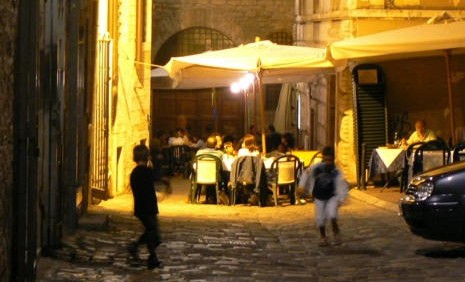
Having abruptly fled the crime-scene their 2nd imperative was not-to-be-caught-in-possession-of-Meredith’s-telephones.
Avoid Police!
Just seeing police could panic the killers into instant dumping of the telephones, without even needing to know why the police were where the police were (There is no need to invoke any awareness by the phone-dumper[s] of the reason the Police were near Mrs. Lana’s place - the hoax-call.). So if the killers saw flashing police-lights, or any other sign of police near Mrs. Lana’s place, that sign could be enough to explain panic phone-dumping - then and there (not considering whether the phones were switched-on or switched-off).
In “Darkness Descending” page 13, it states:
Mrs. Lana’s backyard overlooks a steep slope that falls sharply into the valley below. It is heavily overgrown with trees and bushes, an ideal place to dispose of evidence. If the phones had fallen just a few yards further, they would certainly have gone over the edge of the cliff, down into a 50m gully, straight into a thick scrub of nettles, and probably been lost forever”¦.
In “Death in Perugia” Follain states (Book page 62; Kindle Locations 343-6), apparently as his opinion re Lana’s daughter finding Meredith’s English phone: “It was hidden in some bushes, and she would never have found it if it hadn’t started ringing.”,
Having accomplished this 2nd imperative, Meredith’s killers paused to attend to their 3rd imperative: re-model the crime-scene, minimising the evidences of their identities, cleaning-up the evidences that it was “˜an inside job’, and simulating the appearances that it was “˜an outside job’.
One should bear in mind that these killers should have still been overwhelmed by their having actually committed a crime beyond their wildest imaginings.
Their panic impaired their thinking, and their ignorance, immaturity, inexperience, lack of technical resources and their arrogance precluded their selecting deceptions more effective against knowledgeable, experienced professional crime-investigators with a large fund of resources. They probably think that throwing the stone from inside Filomena’s room was a brilliant deception.
They wish it had never happened.
They wish they could make it unhappen (Hellmann/Zanetti got close to fulfilling this wish, but got themselves unhappened by Cassation)
They wish they could prevent the discovery of Meredith’s murder.
They cannot prevent the discovery of Meredith’s murder.
They may be able to postpone its discovery, but not longer than the inevitable return of the cottage-mates, later that day.
They believe that the person who “˜discovers’ a murder may become 1st-suspect.
They may be able to manouevre others-than-themselves into being the ones that make the discovery ““ quite a wily aim.
It is beyond reasonable doubt that
1. Meredith’s killers seized her mobile telephones, and that
2. Her killers did not switch-off these mobile telephones, and that.
3. Her killers threw the telephones into an apparent ravine, landing in Mrs.Lana’s garden, and that
4. This phone-dump was accomplished before 00:10: 31, 2.11.07, and that
5. Amanda Knox caused:
- i. the English phone to ring at 12:07:12 (16 seconds) and be discovered by Mrs.Lana’s daughter only because it rang , and
ii. the other phone, registered to Filomena Romanelli, to ring, very briefly, at 12:11:02 (3 seconds) and,
iii. the English phone to ring again, also very briefly, at 12:11:54 (4 seconds), after being brought into Mrs.Lana’s house.
6. Sollecito had more than 5 days, from about 11.30 pm on November 1st, 2007 until November 6, 2007, to remove from the killing-knife the traces of Meredith’s DNA.
In the opinion of the Court of Assizes (Massei Translation p.325), Amanda Knox’s call to Meredith’s phone was
...the first indispensible step before putting the [348] planned staging into action. The lack of a reply, since the poor girl was obviously already dead, gave a reason for reassurance about the fact that the young woman’s phone had not somehow been retrieved, [and] was therefore safe in the spot where it had been thrown, which, according to the expectations [in the minds] of the murderers was a precipice or some other inaccessible spot, rather than in the garden of a villa located barely outside the city, where the vegetation concealed it from view.
A plausible alternative opinion is that Knox’s calls to the obviously already dead Meredith were an obfuscatory stab to simulate what Knox imagined an innocent person would do.
Knox may well have expected that she was safe from phone-discovery, but these calls turned out to be the very instrument of a phone-discovery.
Had Knox not made these obfuscatory stabs, in the time-frame she made them Meredith’s phone would not have rung when it did ring and would therefore not have been discovered by Mrs, Lana’s daughter when she did discover it.
For the day of 2.11.07, when Meredith was already dead, the traffic registered for the Vodafone number was shown to be the following:
[MKS ““ 00:10:31; duration and caller unspecified, but Wind signal [cell] incompatible with cottage, but compatible with Mrs. Lana’s place.
Therefore, Meredith’s mobile cell-phone had already been taken away from the cottage by her killers. It is not possible to determine from this phone-record whether the phone was switched on or off, but this phone was discovered at Mrs. Lana’s place because it was ringing, and therefore was “on”.
MKS− 12:11:02 (duration of 3 seconds): Amanda’s phone call reached the phone and was diverted to the answering service. The Vodafone cell used by Meredith’s service provider was situated in Strada Vicinale S. Maria della Collina sector 1.
AKP− 12:11:54 (4 seconds): another call is made towards Meredith’s English mobile phone number (the cell used is the one in Via dell’Aquila 5-Torre dell’Acquedotto sector 3, thus compatible with Sollecito’s house)
RSP− 06:02:59 Raffaele Sollecito received the SMS from his father wishing
Raffaelle a good night; from the evidence of the mobile phone record printouts of Dr. Francesco Sollecito, it was shown that the sending of the message occurred at, as has been said, 23:41:11 of 1.11.07. This was the last SMS sent from that mobile phone during the whole day of 1.11.07]
3+ Hours after receiving his father’s message from 23:41:11 of 1.11.07:
[RSP− 09:24 Raffaele Sollecito received a phone call from his father lasting 248 seconds]
At this time RS’s consiousness would be dominated by his guilty knowledge, and probably far-advanced in the accomplishment of the 3rd imperative.
Did RS and father spend 4+ minutes discussing the weather?
This is the first father/son opportunity to formulate the two-pronged water-leak story.
Although AK had already been to the hardware store 2 hours before, they may well not have known the potential DNA problems with the knife, the need to scrub it vigorously, to clean-out, and repair the drain-pipes under the sink, and the need to return the knife to RS’s kitchen drawer.
As it turned-out, Sollecito had more than 5 days, from about 11.30 pm on November 1st, 2007 until November 6, 2007, to remove from the killing-knife the traces of Meredith’s DNA.
They probably did not know that incriminating stains could be invisible, but can be revealed byLuminol.
RSP− 09:29 another call was received lasting 38 seconds
RSP− 09:30 (duration unspecified?) the father called Raffaele; the call connected to the Vial Belardi sector 7 cell.(the best server cell for Corso Garibaldi 30).]
These two calls were probably spent dotting “˜i’s, crossing “˜t’s, and exchanging options, such as enlisting sister Vanessa’s skills and contacts.
Another 2+ Hours later:
[AKP− 12:07:12 (duration of 16 seconds) Amanda calls the English phone number 00447841131571 belonging to Meredith Kercher. The mobile phone connects to the cell at [346] Via dell’Aquila 5-Torre dell’Acquedotto sector 9 (the signal from this cell is picked up at Sollecito’s house)
AKP− 12.08.44 (lasted 68 seconds) Amanda calls Romanelli Filomena on number 347-1073006; the mobile phone connects to the Via dell’Aquila 5-Torre dell’Acquedotto sector 3 cell (which covers Sollecito’s house)
Discovery will be inevitable when Filomena eventuallyarrives-back at the cottage.
AK/RS have accepted that they have to “˜stand-pat’ with their efforts so-far to accomplish their 3rd imperative.
Amanda did not say a word in this phone-call to Filomena about Amanda’s phone call to Meredith, thereby withholding information that should have led Amanda to initiate discovery of Meredith’s body, and help Amanda to manouevre someone other than Amanda into being the one who “˜discovers’ Meredith’s body.
AKP− 12:11:02 (3 seconds) the Vodafone number 348-4673711 belonging to Meredith (this is the one [i.e. SIM card] registered to Romanelli Filomena) is called and its answering service is activated (cell used: Via dell’Aquila 5-Torre dell’Acquedotto sector3)
MKS: For the day of 2.11.07, when Meredith was already dead, the traffic registered for the Vodafone number was shown to be the following:
− 12:11:02 (duration of 3 seconds): Amanda’s phone call reached the phone and was diverted to the answering service. The Vodafone cell used by Meredith’s service provider was situated in Strada Vicinale S. Maria della Collina sector 1.
AKP− 12:11:54 (4 seconds): another call is made towards Meredith’s English mobile phone number (the cell used is the one in Via dell’Aquila 5-Torre dell’Acquedotto sector 3, thus compatible with Sollecito’s house)
AKP− 12:12:35 (lasting 36 seconds) Romanelli Filomena calls Amanda Knox (No. 348-4673590); Amanda receives the call connecting to the cell on Via dell’Aquila 5-Torre dell’Acquedotto sector 3 (still at Raffaele’s house)
AKP− 12:20:44 (lasting 65 seconds) Romanelli F. calls Amanda, who receives the call connecting to the cell in Via dell’Aquila 5-Torre dell’Acquedotto sector 9 (good for Corso Garibaldi 30)
AKP− 12:34:56 (48 seconds): Filomena calls Amanda who receives it from the cottage on Via della Pergola 7 (the cell used is that on Piazza Lupattelli sector 7. As mentioned, Raffaele also used the same cell when he called the service centre at 12:35 hours to recharge [the credit of] his mobile phone)
RSP− 12:35: Raffaele’s mobile phone contacted a service centre for a phone [credit] recharge (the cell used was that of Piazza Lupattelli sector 7, which gives coverage to the little house on Via della Pergola 7. The signal in question does not reach Corso Garibaldi 30, which instead is served by the signal from Piazza Lupattelli sector 8)
RSP− 12:38: Vodafone sent a message of confirmation of phone [credit] recharge (Piazza Lupattelli sector 7 cell, good for Via della Pergola 7)
RSP− 12:40: incoming call from the father’s mobile phone (lasting 67 seconds; connection through Piazza Lupattelli sector 7 cell, compatible with the Sollecito’s presence near the little house)]
Do RS and father exchange caveats?
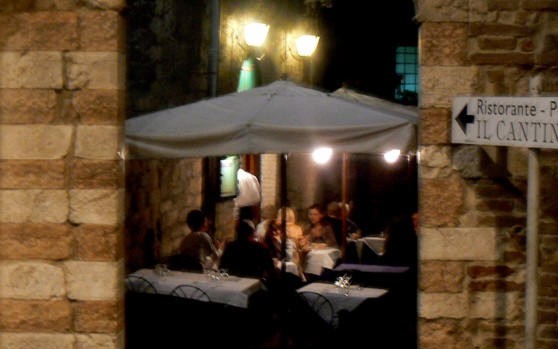
[AKP− 12:47:23 (duration of 88 seconds): Amanda calls the American (USA) number 00120069326457, using the cell on Piazza Lupatetlli sector 7; the phone call takes place prior to the one which, at 12.51.40, Raffaele Sollecito will make to “š112”›, connecting to the cell on Via dell’Aquila 5-Torre dell’Acquedotto sector 1, which gives coverage to Via della Pergola 7]
In “Waiting To Be Heard” Knox can hardly deny having made this 1st call, acknowledges making the call, and purports, now, to recall its substance, providing the reader with her version of what was said.
[AKP− 13:24:18 (duration of 162 seconds): Amanda calls the same American number which corresponds to the home of her mother, Mrs Edda Mellas, using the same cell. It is obvious that the young woman is inside the cottage, where by this point, several minutes earlier, the Postal Police had shown up, [347] represented by Inspector Battistelli and Assistant Marzi, who were engaged in the task of tracking down Filomena Romanelli, who was the owner of the Vodafone phonecard contained in the mobile phone found earlier in the garden of the villa on Via Sperandio]
In “Waiting To Be Heard” Knox can hardly deny having made this 2nd call either, she acknowledges making the call, and provides the reader with her current version of what was said.
[RSP− 12:50:34 outgoing call directed at mobile phone 347-1323774 belonging to Vanessa Sollecito, sister of the defendant; duration 39 seconds. Connection to Piazza Lupattelli sector 7 cell 320
RSP− 12:51:40 Raffaele Sollecito called “š112”› to inform the Carabinieri of the presumed theft in Romanelli’s room (duration 169 seconds; connection to Via dell’Aquila 5-Torre dell’Acquedotto sector 1 cell, which covers Via della Pergola 7)
RSP− 12:54: a second call by Raffaele to “š112”› (57 sec.; connection to Piazza Lupattelli sector 7 cell)
MKS− 13:17:10 (lasting 1 second): the cell used was located in the same place, sector 7
AKP− 13:27:32 (duration of 26 seconds): Amanda calls the American number 0012069319350, still using the cell at Piazza Lupattelli sector 7.
AKP− 13:29:00 (duration of 296 seconds) Amanda receives [a call] from No. 075/54247561 (Piazza Lupattelli sector 7 cell)
RSP− 13:40:12: incoming call from the father (94 sec.; Via dell’Aquila 5-Torre dell’Acquedotto sector 1 cell)]
AKP− ?13:48:33 (1 second): this is an attempted call to her mother’s number
““ see below at 13:58:33
AKP− 13:58:33 (1 second): this is an attempted call to her mother’s number
The above item is a faithful translation from the Massei Motivazione section on Amanda Knox’s mobile phone traffic, but is listed out-of-time-sequence; the assigned-time is probably a “˜typo’ ““ “13:48:33” is much more likely correct.
[RSP− 14:33: the father called for 21 seconds (as above)]
Do RS and father exchange more caveats?
[AKP− 14:46:14 (102 seconds) Amanda receives a call from the German number 494154794034, most likely belonging to her aunt Doroty Craft
MKS− 15:13:43 (5 seconds) cell not indicated.
AKP− 15:31:51 (1 second): Amanda receives an SMS sent from the number 389/1531078; at this point the cell being used is the one on Via Cappuccinelli 5/A sector 2, where the Questura [police headquarters] is located
In the hours that followed the [mobile phone record] printouts show that the answering service of Amanda’s number 348-4673590 was activated due to a lack of signal coverage.]
Massei Translation p.324:
Finally, the analyses of the [phone record] printouts highlight that the first phone call made by Amanda on the day of 2 November was to Meredith Kercher’s English number.
The American student called her English flatmate even before contacting Romanelli Filomena to whom she intended to express, as she testified in court, her fears about the strange things she had seen in the cottage, which she had returned to at about 11 o’clock in order to shower in preparation for the excursion to Gubbio which she and Raffaele had planned.
It is strange that Amanda did not say a word to Filomena about the phone call to their flatmate, when the call, not having been answered, would normally have caused anxiety and posed some questions as to why Meredith did not answer the phone at such an advanced hour of the day.
[RSP− 17:01: the father called for 164 seconds; cell used is that of Via Cappucinelli 5/A sector 2, corresponding to the location of the Perugia Police Station
RSP− 17:42: the father called for 97 seconds (as above).
With regard to Raffaele Sollecito’s landline home phone (No. 075-9660789)
The above 2 calls presumably covered final agreements on the Father/son stories.
For the entire day of 1 November and then of 2 November, Raffaele Sollecito’s fixed line was not affected by any calls, either incoming or outgoing.]
This finishes the merged listings of the Massei sections on AKP, MKP, and RSP, using the UPC telephone traffic, reappraising the more probable scenarios surrounding what happened at 7 Via della Pergola, in Perugia on the night of November 1-2, 2007.
Readers are invited to make their own suggestions on probable scenarios, here below or in email.
Sunday, June 23, 2013
A Summary Of The Cassazione Ruling On Annulment Of The Knox-Sollecito Appeal
Posted by Machiavelli

[Above and below: justice-themed artwork in Cassazione; motifs are used all over the world]
1. Introduction
On June 18, 2013 the Supreme Court of Cassazione issued the official rationale for the sentence of annulment of the Hellmann-Zanetti verdict.
That verdict acquitted Amanda Knox and Raffaele Sollecito on the charge of murder and sexual violence, while finding Knox guilty of the crime of calunnia (obstruction of justice by maliciously placing false accusation against a person you know is innocent).
Previously I posted here a summary of the recourse to the Cassazione by the Umbria Prosecutor-General Dr. Galati and Prosecutor Dr. Costagliola which demanded an annulment of the appeal verdict. I also posted here a first summary report, from the March 25-26 Supreme Court hearing, when the Hellmann verdict was annulled and thus prosecution recourse was won.
The 74-page motivation report states clearly that Cassazione “accept the points of the recourse” from both the Prosecution and the Kercher parties, while they reject the Knox defense recourse.
While you will realize it yourself in reading it, I can say in advance that what the Supreme Court points out in the appeal verdict is a pattern of manifest violation of an unprecedented gravity. All those I know in the law professions have never seen, throughout their professional lives, a Cassazione bashing portraying such a concentration of flaws in one verdict.
Mostly written by Judge M. S Caprioglio (possibly including parts by Judge Severo Chieffi) the document features a sophisticated Italian language and a formal style.
The first half of the report is a summary of judicial events and arguments made by the parties through the previous instances. The second part basically dismantles all the points of reasoning of the Hellmann-Zanetti verdict, without spending too many words for each one of them.
2. A premise about the concept of legitimacy judgment
The second part is introduced by an explanation about what a “legitimacy judgment” is, about its scope and boundaries. The Court is called to assess 1) whether the judges of merit indicated reasons for their decisions, and 2) if reasons are logically argued and legally founded.
The meaning of “logically argued” is that the Court shall verify that the lower judge actually did take into consideration the evidence included in the trial file (“principle of completeness”), and if reasoning is consistent with them, and with the law. The Court “being a “court of legitimacy” [decides on legitimacy of the process that lead to conclusions, not on the merit] “does not assess directly the existence or the quality of the pieces of evidence, but may well assess the quality of reasoning about it and its actual consistence with the evidence in the file”.
So the legitimacy judges staying within their boundaries are not prevented from assessing whether the lower court followed logical criteria, meaning assessing if arguments used by the lower courts are plausible, as well as if their reasoning is “complete” and truthful with respect to the evidence file. The Supreme Court is also allowed to access the evidence trial documents for the parts that may conflict with the verdict conclusions.
The Court states that the present case is obviously based on circumstantial evidence, but points out how circumstantial evidence is not less powerful or logically less valuable than direct evidence.
While remaining within the boundaries of the legitimacy judgment, the Court notes anyway that at first sight in the Hellmann-Zanetti verdict there is an obvious “parceling out” of the pieces of circumstantial evidence. This means a lack of assessment also of each piece of circumstantial evidence, since the judge failed to check whether the possible flaws and lacks in the logical value of each single piece of evidence could be filled by crossing them and taking in account the whole set of them.
The Court also notes however that the judges’ conclusions also openly contradicted some of the pieces of evidence: they neglected or “overlooked” them in some cases, or dismissed some pieces on which the previous reasoning was based without offering adequate reasons. Moreover the pieces of evidence were also not “adequately elaborated”, and the pieces of reasoning about them were “not coordinated”.
3. The Amanda Knox calunnia
Reversing the order of topics from the Galati-Costagliola recourse, the Court deals first with the charge of calunnia for which Knox was convicted twice [obstructing justice by accusing a person who you know is innocent] (p. 41-44), since on this topic there is a converging of all recourses and unanimity by all judges. The appeal court had dismissed a possible link between the calunnia and the murder charges, but the explanation provided for that appears obviously illogical.
The Hellmann-Zanetti scenario - by which, they say, Knox may have voluntarily accused an innocent man just because she was pressed by investigators, thus for a purpose totally independent from the intent of obstructing the investigation on the charge of murder “is argued in a way that conflicts with and neglects the actual evidence documents”.
While Hellmann-Zanetti argue solely based on a police interrogation scenario as if the false accusation was an event confined within it, the Cassazione does not see Knox’s calunnia as a single event nor as a behavior limited to the situation of the interrogation, but rather as a prolonged behavior extending over a time of many hours and days (“perduranza in atteggiamento delittuoso”). Basically Knox goes on implicating Lumumba repeatedly, and she repeatedly provides false evidence, such as through her hand-written note “where she stands by what she declared” and by her subsequent behavior.
The Court also observes the evidence file contains evidence that was overlooked by Hellmann-Zanetti indicating Knox was aware that Lumumba was innocent, such as the recording of prison dialogues with her mother, where she says she feels guilty for having accused Patrick “a feeling of guilt implies an assumption that he was innocent”.
So the appeal court made mistakes because they lacked inference from pieces of evidence, mainly neglecting to argue elements like the discussion with her mother, her written memoir including the repetition of pieces of false testimony and her court admissions that she wrote her memoir voluntarily.
It points out (p.42) that Knox albeit young was a “mature” person meaning she had an adequate cultural level and education and would be able to regain control of herself afterward even if she had suffered a coercion or a moment of emotional breakdown. Knox would be basically able to understand the gravity of her declaration over a period of time.
If only one single event, such a false accusation caused by pressure, breakdown and stress could have been argued “in the abstract” in the way Hellmann-Zanetti did, considering the calunnia as a choice resulting from an episode of emotional breakdown, but the Hellmann-Zanetti reasoning neglects the actual documents and is not fit to explain the persisting and repeated false testimony.
The Supreme Court reminds that “information about commission of a crime” can be derived also from the interrogation of a police suspect, even from information released by a suspect who had not be read their rights under Art. 64, even from statements that are not usable for lack of defensive rights, and even that in the event the interrogation is to be nullified.
In all these cases the suspect commits a calunnia whenever he/she voluntarily and falsely accuses someone to defend himself/herself (so there can’t be any consequential link between the legal status of the interrogation, and the charge of calunnia or the collecting of information about a crime).
The Cassazione also points out that the Hellmann Zanetti rationale is illogical when it states that “the easiest way out” for one guilty “would have been to accuse the real author of the crime”. The inference obviously does not consider that she may be herself among the real authors of the crime (especially since she lived there and had access to the scene of crime).
The Court also points out the failure to properly address the importance of the details contained in the Knox false testimony (the detailing of this is in subsequent chapter).
4. The crime scene staging
The Cassazione accepts the Prosecution General point of recourse complaining about the failure to consider the evidence of staging a burglary, and says the recourse is “founded”. The pieces of physical evidence suggesting a staging are not satisfactorily argued or refuted by Hellmann-Zanetti.
The Hellmann-Zanetti appeal court also argued in favor of the “lone perpetrator scenario” by introducing some assertions which are unacceptable since they openly “collide” with the trial documents or are unfounded. Basically their reasoning was hinging on elements such as speculations about Guede’s personality, they introduced allegations like a purported habitual burglar profile, not backed by any evidence.
On the other hand they bring in arguments “like that about a glass shard in Meredith’s room” which have zero implications in their scenario (because they are equally good to argue in favor of a staging).
They should have argued “in favor or against” about evidence of burglary/staging based on the assessment of the pieces of physical evidence found on the scene, like argue against Massei’s reasoning about the ones mentioned in the first trial, say why it was not good. On the other hand the break-in scenario, as described by Hellmann-Zanetti, is affected by “multiple logical ruptures”, details are not explained consistently.
Moreover the Court says a scenario involving the issue of burglary/staging should be argued based on the overall evidence about Rudy Guede, meaning a scenario involving the whole of what he had done, like explain all the traces that show his movements, for example the trail of bloody shoe prints showing that he left the murder room straight away.
There are aspects of the reasoning that are “tautological” (circular and begging the question).
The Hellmann-Zanetti reasoning on the same point is also neglectful of part of the file sources (is based on a “partial access to information”), for example it overlook testimonies concerning wounds on Guede’s hands, dismissal of glass on top of items. To sum up, the rationale employs inadequate inferential principles and incorrect information.
5. Man in the park Curatolo’s testimony
Hellmann-Zanetti had dismissed the testimony of Antonio Curatolo.
Their statement about the reliability of Curatolo is totally “censurable”, since it is “apodictic” [assumed as a premise “true in advance” without explanation], and not based on thorough analysis of the data. In particular when they state that he tends to confuse days dates: such assertions are both unfounded and illogical since conflicting with the testimonies of himself and of others witnesses. The Court does not assess the reliability of Curatolo as a witness, but notes that the reasons brought by Hellmann-Zanetti are unacceptable.
The possibility to explain elements of the testimony by mistake of date by the witness, so placing his testimony possibly on Oct 31. is conflicting with the other evidence, namely the testimonies showing the defendants were elsewhere on the 31st. Moreover the elements used for the argument are logically weak compared to the strength of the elements showing Curatolo correctly “anchoring” his testimony to real events.
Then the lower court introduced “as further basis of reasoning” assertions in order to “jump” across the whole of Curatolo’s testimony: they based their conclusion on the asserted “decaying intellectual faculties”, on his use of heroin, and on his modus vivendi.
However they do not offer any element of evidence about the alleged mental decay, they fail to show this through analysis of his testimony, and in fact they completely fail to analyze the actual content and consistence of his testimony (lack of “completeness”). The use of heroin and his modus vivendi (as a “bum”) is also not acceptable as a reason for dismissing reliability of a witness, this would be an arbitrary judgment that violates the principles of witness assessment.
Since the witness was very assertive, consistent and felt certain about his testimony, the court would need a logically strong argument “based on some other finding or certainty” in order to dismiss his reliability (dislikes about his lifestyle or disproven speculations about date mistakes are not).
6. Shopkeeper Quintavalle’s testimony
The Court pretty quickly dismisses the Hellmann-Zanetti conclusions about Quintavalle, on grounds that they are based on a “cherry picking” and twisting of information from the documents, basically they misinterpret and neglect to consider the actual content of the Quintavalle’s testimony.
In fact the summary description of Quintavalle’s testimony that was offered by Hellmann-Zanetti is basically a misrepresentation based on incomplete parts of the testimony and overlooking of others, and flatly contradicts the content of actual testimony (it is not what Quintavalle and witnesses actually said).
It is not true that Quintavalle remembered about recognizing Knox one year later, documents show that he was sure about her identity from the early investigation - the Cassazione quotes some of Quintavalle’s statements where he remarks her circumstances and features.
Hellmann-Zanetti reported some bits of information in a fragmentary fashion without taking into account the explanations of Quintavalle and the answers he actually had given through the investigation.
The appeal court should have analyzed the whole of what the witness actually said, and crossed the statements with the existing information, instead of selecting cherry- picked bits and pinned on them a meaning out of context.
The Cassazione is not interested in assessing the reliability of the witness Quintavalle, but they find “intolerable” that Hellmann-Zanetti give a false picture of the testimony, in a way disjointed from the true content of the trial documentation.
7. The failure to consider implications of Knox’s memoir
The Prosecutor General was right in blaming the Hellmann-Zanetti court for neglecting to evaluate the hand written note written by Amanda Knox as a piece of circumstantial evidence. The appeal court dismissed the memoir as useless on the sole basis that it does not have a substantial meaning (actually: that it did not represent the truth).
But this argument is insufficient (and circular); it is also “structurally” inconsistent because the same Hellmann-Zanetti court used the very same note as a piece of evidence in the calunnia charge, and cannot be logically linked to pressure because she wrote it alone on her own initiative and not during an interrogation.
The Court details the content of the note pointing out that in the hand written memoir there is a repetition of some of the details from her previous “spontaneous statements”, which are now only set in an oneiric [dream-like, surreal] frame (they “seem unreal”) but yet they are the same peculiar details from the false accusation.
The Court also highlights the new “sibylline” [ambiguous and threatening] accusation by Knox against Sollecito (remembering blood on his hands, but probably from fish).
The next appeal court will need to build some actual arguments to explain these features, taking in account that “as for Hellmann-Zanetti” she wrote that while she was fully capable to understand and without any pressure from authorities.
The contradictory nature of the appeal court reasons on this point is “obvious”.
8. Failure to consider judicial files from Guede’s definitive sentencing
The Court spends a bit more than one page to explain why the prosecution recourse is correct in their complaint on this point as well. In fact Hellmann-Zanetti did accept the Guede verdict as a piece of circumstantial evidence, but argued that that piece was “particularly weak”.
However, the problem is that in reality they did not assess it at all in order to come to that conclusion, but they rather just completely ignored the whole content of the Guede verdict reports.
The court is not authorized to dismiss a piece of evidence which they formally entered without assessing it, just on “in limine” reasons. Therefore the decision openly “violates the law” (p. 55).
The Rudi Guede verdict motivations theoretically might be found “particularly weak” as a piece of circumstantial evidence, but it can’t be ruled “particularly weak” on the reasons declared by Hellmann-Zanetti.
The appeal court did not try to argue the logical passages of the Guede verdict in order to assess it and explain why conclusions were weak, instead they decided to ignore it, not based on the analysis of its content but instead based on the legal nature of the document. This is a patent violation of the law, and a conflict with the trial documents.
Thereafter the Hellmann-Zanetti court steered the discourse onto the alleged “habitual criminal” profile of Guede (an interpretation based on speculation) without explaining the reasons for building a scenario about Guede so far-fetched compared to the findings in the trial’s files about Guede.
Moreover the appeal court adds a further, false and illogical argument when they state that, even if Guede was proven to be guilty of concurring with others, this does not have implications for Knox and Sollecito at all because those accomplices could have been other people. The alleged lack of implication is false under logic, because determining that Guede acted together with others would additional information on the crime, which could be crossed with other information (such as about who had access to the apartment etc.).
The Court also remarks that the trials had found and explicitly declared Guede innocent of the crime of burglary, and the appeal court also fails to deal with this in their alternative scenario.
The appeal court also failed to consider other information from the findings of the Guede trial, and explicitly contradicted it without justification, for example they neglected to consider how the courts had determined through multiple witnesses that Guede actually did not have any injury on his hands on the night after the murder [Guede had cuts on his hand, but many days later, not the night after the murder].
9. Declarations of Rudy Guede at the Knox-Sollecito appeal
There is an open violation of the law in the Hellmann-Zanetti motivations, in the particular statement where they assert that Guede’s declarations in the courtroom were unreliable for the reason that he refused to undergo a questioning.
The reason brought by Hellmann-Zanetti to rule unreliability is illegitimate when referring to the specific declarations of Rudy Guede in the Knox-Sollecito appeal, and legally not true.
First, the Cassazione notes that the decision to refuse a questioning pertaining to a crime is within the rights of a witness who is implicated in the same crime. If the witness decided to invoke this right, the courts and the parties are bond to enforce it and limit their questions within topics unrelated to the crime, and under the law, no conclusion about reliability/unreliability can be drawn solely from the witness’s decision to refuse to answer about a topic in which he was implicated as a defendant.
No court could conclude that a witness is unreliable on the sole ground that he enforces his rights.
Moreover, preventing an interrogation of the witness on such topics is just a duty of the Prosecution and the Court, not a ruling “in favor” of the witness (and co-defendant).
The Prosecutor General had summoned Guede to testify only about the topic of things he said during conversation with inmates and letters he wrote from prison, and since the witness invoked his right as an ex co-defendant the Prosecutor General had the duty to enforce the limitations on his questioning.
It was the Sollecito-Knox defence attorneys who attempted to place questions directly on the topic of the events of Nov. 2, 2007, and they asked Guede to confirm the content of his letter directly pertaining the Kercher murder. The defence asked him to confirm if one particular statement of the letter he wrote was true, and the statement of Rudy Guede confirming his Knox and Sollecito implication and accusing them of murder was only in response to this, stemming from the defence question.
The declaration of Rudy Guede might be considered irrelevant as a piece of circumstantial evidence; and the witness might be assessed as unreliable by a court, but this cannot be done based on the illegitimate grounds brought by Hellmann-Zanetti. You cannot have, as an argument for unreliability, the fact that Rudy Guede chose the legal option of not undergoing a questioning about the murder.
The Cassazione also notes how the Hellmann-Zanetti report details some of Guede’s declarations in order to argue for his unreliability. However the cited statements from the Skype conversation with Giacomo Benedetti are used by Hellmann-Zanetti just to build an illogical argument: they say Rudy should have logically indicated the true culprits in that call, the fact that he does not accuse them is an indication that they were not there.
This argument is flawed (besides contradicting the very same claim about Guede’s unreliability). The Cassazione sees the weakness of reasoning about the Skype call as “symptomatic” of the lack of logical consistence of the appeal court on the topic of Rudy reliability, and it also reveals that the criteria they are following are not compatible with logic.
The appeal reasoning is also contradictory on further points, as Hellmann-Zanetti consider some declarations of Guede “reliable” without logical reason - like about the timing of death, where the appeal court considers Rudy’s statement reliable without considering that he had an obvious logical interest and an attitude of misleading the accusations by providing details that were conflicting with evidence.
Paradoxically, had the Hellmann-Zanetti court followed the same criteria on other declarations, they should have considered Guede’s declarations “reliable” when he says “Amanda is not implicated”, as well as when he says - talking about Sollecito - “I don’t know, I think it’s him” . The appeal court did not follow the principle of completeness and they did not consider these.
The Hellmann-Zanetti report also fails to consider that Guede was assessed as “totally unreliable” by his trial judges (they could have used such finding in documents to argue unreliability of his statements instead; if they had only read the Guede verdict). In other words they worked inconsistent arguments out of on an incomplete set of data.
10. The refusal to listen to the whole testimony of witness Luciano Aviello
The appeal trial was procedurally flawed also by the refused to call Luciano Aviello before the court again, as he was supposed to complete what was left out of his testimony.
Luciano Aviello was called as a witness by the court in accepting a defence request; after his hearing, during the course of the trial, new elements emerged “new witness declarations” that created a necessity to put some further questions to the witness.
The Hellmann-Zanetti court refuse to call back the witness to complete the questioning, despite that he had already been accepted as a witness by the same court. So the witness was basically prevented from completing his testimony.
The Cassazione does not argue about the reliability of Aviello as a witness (nor about the relevance of his testimony) but points the finger against the inconsistency of Hellmann-Zanetti’s ruling, which causes their decision to be illegitimate.
The refusal to call back the witness to complete his testimony at a second hearing was manifestly inconsistent, since that violates the principle of completeness (once you call a witness, you need to be ready to listen to all that he has to say).
The court’s decision was “unacceptable” (p. 58) also because it was based on arbitrary criteria - as Hellmann-Zanetti said “another hearing of the witness is not indispensable” on the ground that minutes of his interrogation were entered in the file: the decision violates the principles of usability of documents and the rules of witness hearing.
The appeal court completely ignored the reasons for and the new content of the topics Aviello was to be questioned about, and did not assess them. Instead, they violated articles 511, 511bis and 512 of the procedure code by “replacing” it with non-usable minutes of his interrogation.
The judgement of “non-indispensable” was also unfounded, manifestly so compared to the importance of the topic which referred to the explanation and completeness of Aviello’s testimony. A plot concerning a secret agreement in order to offer false declarations in court is obviously a topic with some relevance.
There is also a violation of the principle of confrontation, because Aviello was a defence witness and the Prosecutor General had the duty of carrying on an assessment of the witness within the appeal trial by cross examination (Hellmann-Zanetti’s decision allowed only the piece of testimony that could be favorable to the defence, and they cut off the part that could be unfavorable).
The motivation is also incomplete as Aviello is ruled “unreliable” a priori because of his retraction (which Hellmann-Zanetti apparently considered reliable) and irrelevant as a piece of evidence without actually listening to the content of his testimony, to what he had to say.
The testimony of Aviello could not be “cut off” that way and could not be considered unreliable a priori without listening to it.
11. The re-framing of the time of death
The Court devotes four pages to explaining how Hellmann-Zanetti’s reasoning about re-location of the time of death is illogical.
The appeal court refused to anchor the timing (and further features, noises etc.) of the screaming, to the time frame offered by two witnesses, Nara Capezzali and Antonella Monacchia. They also dismissed the testimony of Mrs. Dramis. Instead they accepted the defence idea of determining the time of death based on the statements by the “unreliable” Rudy Guede. They put the time of death in relation to the phone calls, around 9pm.
As for the Cassazione, such an argumentation path is woven through with “conjecture and illusions” (p. 61). The bases chosen for inference are devoid of any factual validity, as opposed to the elements of evidence which were discharged, which are instead extremely relevant.
The Hellmann-Zanetti report refutes the elements (testimonies of Capezzali, Damis, Monacchia) with arguments which are riddled with obvious, multiple inconsistencies [like the claim that a half-an-hour error would make the testimony unreliable, or that Nara’s looking unsure between the dates of Nov. 1. or 2. makes the scream attributable to something else, as if she was used to hearing blood-curdling screams every other day and as if the Monacchia confirmation testimony didn’t exist].
So the Hellmann-Zanetti rationale dismisses as “unreliable” or “useless” some very relevant and consistent testimonies (from witnesses they declare “credible”), while on the other hand, it accepts as “reliable” a dictum by Rudi Guede and builds a theory of the time of death on it - despite the defence itself having pointed out how Guede was totally unreliable and was also very able at changing and twisting every detail of his story, all the time and on any occasion, from the earliest stages of the investigation.
The Cassazione states - without any possibility of question - that it is manifestly obvious that things Guede consciously stated on the Skype conversation could never be used as the main credible source to build an inference about the time of death.
Moreover the Court points out that in fact the appeal court cherry picked just one statement by Guede, regarding the time of death, and considered it “credible”, while neglecting to note how within the same Skype conversation Guede also made a number of assertions about Knox
These included statements that place evidence against Knox and Sollecito. While in the same conversation Guede says “Amanda was not implicated”, he also states that Amanda was in the house; he states remembering that in Romanelli’s room the window appeared intact, and denied having broken it, he inferred that Knox and Sollecito must have done it; he also assumed that they must have altered the scene of the crime and the victim’s body; he also said he thought the man he saw was probably Sollecito.
The Hellmann-Zanetti court simply neglects to consider and deal with the whole information from the Skype call, which they instead elect to reliably source solely regarding Guede’s declaration about the time; so “besides illogicality in the unfounded dismissal of other testimonies” their method of processing information violates completeness and consistency.
The appeal court is also extremely weak where they try to fill the logical gap by drawing further inference from Meredith’s phone records. The attempt to link a mistaken phone call with the time of death is simply inherently implausible, a wrong call is a trivial event and there is no reason to make such link; also the delay by Meredith who did not call her mother again within the next half an hour is a trivial element which doesn’t have a specific implication upon the time of death.
The worst Hellmann-Zanetti did on this topic is the downplaying and underestimation of the testimonies of the three witnesses - Capezzali, Monacchia and Dramis.
In fact Capezzali described the scream in detail, picturing it with a number of features - “harrowing”, “unusual”, “long”, “isolated” and stressed its uniqueness and added additional information about noises (gravel path etc.) unequivocally linked to the cottage, she made clear that she never heard something similar before.
Monacchia was even more precise about the timing, since she went to sleep at 10.00 pm and slept for a while; Dramis came home back from the cinema at 10:30 pm. Their timings converge in placing the timing of an isolated scream later than 10:30 pm.
On the basis of Nara Capezzali’s testimony, it is absolutely unreasonable for the appeal court to assume that Nara could confuse the scream with the usual other “noises” of “junkies”.
Dramis as well referred to having been awaken by some noise of a kind she never heard before. Hellmann-Zanetti ruled out the time frame offered by the testimonies of Monacchia and Dramis for no reason except that they gave their testimony one year later; this is a totally insufficient and illogical reason.
As for considering Rudy as a reliable source, instead it is acknowledged that Guede was obviously lying and following a pattern of behavior/strategy of providing a flow of false details to muddle investigation.
The Court adds that neglecting the importance of information about the scream seems even more stunning when you consider the fact that the scream coincides with a detail that was mentioned in an early testimony of Knox [and even in declarations of Guede].
12. The court appointing of new experts and their management
This point may be the most interesting because it is the only topic on which the Supreme Court doesn’t agree entirely with the Prosecution General.
The Prosecution’s complaint was “˜partly’ correct about objecting to the legitimacy of the appeal court appointing new experts.
The point of recourse is founded insofar as the appointing was insufficiently motivated in the rationale: the reason expressed ““ basically addressing just the judge’s lack of scientific knowledge ““ is inconsistent, and also inadmissible because it violates the principle of non-delegation of judgment.
However, the judge’s decision of appointing experts itself should supposedly always be based on assessments of the merits of the evidence. The Cassazione cannot decide on the merits, so the decision about whether more expertise is necessary or not, which was supposedly taken based on the evidence available, is an exclusive competence of the judge of merit and the High Court can’t discuss it.
The absence of consistent motivations for the appointing reveals an insecurity of the appeal court about the evidence, which they (rightly or wrongly) attributed to incomplete information. However, the peculiar way the appeal court subsequently managed the experts is censurable.
The experts decided to not test the new DNA sample, despite the fact that the amount was 120 picograms [so much more than “˜5 picograms’ as declared by Vecchiotti in court, ed.], on an arbitrary decision by only one of the experts, on the ground that it was a “˜Low Copy Number’. Such a decision ““ itself unlawful ““ was subsequently subscribed to by the appeal court.
When the Prosecution General and consultant Prof. Novelli requested to go on testing the sample, since it was perfectly possible to do so, the court denied, arguing on the false assumption obtained by misquoting Novelli as saying the required techniques were “in the experimental phase”.
This was a misquote, a misinterpretation of a statement by Novelli, and the Court finds it to be false in the documentation: Hellmann-Zanetti incurred a gross misrepresentation of reality as they called the new technology “experimental” and “unreliable”.
Beside this false claim, it was on principle unacceptable that the expert Carla Vecchiotti refused to carry out a test, and that the judge accepted such a decision.
The expert’s decision violated the judge’s previous ordnance, because the written order said that they must require the court’s opinion before taking any decision, not after; the judge’s change also violated their own ordnance, because it withdrew from the previous tasking.
The modus operandi of the court therefore was to let an expert make decisions about their own mandate, based on their own judgment about the subsequent value of their finding in court.
But the experts had no authority to reduce or re-frame their own mandate, it is not up to them to preemptively decide whether their finding is reliable or not and anyway they cannot refuse to accomplish an order or to bring a finding into court; no matter if their finding is unreliable as a piece of evidence, they have to bring it anyway to court discussion, and its value will be determined through court discussion.
Hellmann-Zanetti were incomplete on documenting Novelli’s positions which were expressed during the experts’ testing and are in conflict with the Vecchioti-Conti decisions. They could have chosen Vecchiotti’s positions, but only after having dealt with the arguments expressed by the other side too.
The decisions by which Hellmann-Zanetti managed the experts’ work is also in violation of the principle of equality and the right of all parties to bring evidence, since they ordered a perizia [experts investigation] but then they prevented it from being fully accomplished: they only allowed the research activity by which the defence was seeking evidence, while they prohibited those activities requested by the accusation parties.
Once they ordered new scientific tests, the order should have been completed without any a priori unjustified preclusion. Their unbalanced modus operandi was an alteration of the evidence information set, and a violation of the law (p.66), and cause their motivations to be manifestly illogical.
13. The DNA evidence
The appeal court passively accepted the new experts’ conclusions, while ignoring the opinions of the witnesses Novelli and Torricelli. Their arguments had a comparable degree of importance, and the witnesses had at least the same degree of expertise and authority than the judge appointed experts.
As the judges chose to believe the conclusions of some experts in disagreement with others, they are not obligated to demonstrate themselves that such conclusions are true, but nonetheless they are required to report the arguments made by the other side and they need to deal with them in a reasoning.
This is especially necessary if the expert witnesses have a great expertise and credibility, at least comparable to that of the judge-appointed experts.
Hellmann-Zanetti accepted the C&V report entirely and passively, without confronting it with the opposite arguments and objections. Such procedure is illegitimate, since objections and arguments were not even mentioned.
The Casssazione recalls, among the not-mentioned and not-dealt-with arguments, that Prof. Novelli had calculated a probability of misinterpretation of the alleles on the bra-clasp; and Dr. Torricelli analyzed the Y-haplotype on 17 loci and found no match except Sollecito.
Novelli also testified that recommendations and protocols do exist, but the operator’s competence and common sense in scientific assessment is more important. He also said that the researcher should be always allowed to depart from standard procedures when single situations suggest so.
The judge-appointed experts themselves ruled out laboratory contamination. Novelli analyzed the series of samples from all 255 items processed and found not a single instance of contamination, and ruled out as implausible that a contaminating agent could have been present just on one single result.
Also Dr. Stefanoni testified that the knife was tested 6 days after an alleged contaminating and Vecchiotti confirmed that the time interval would lead to rule out laboratory contamination.
Hellmann-Zanetti also ignored or twisted information regarding the crime; it ignored the finding that no instance of Sollecito’s DNA was found on the scene as a possible contamination source despite may environmental samples; the High Court labels as false ““ going by the evidence file - Hellmann Zanetti’s statement saying that “everybody had walked around into the house”.
Also Cassazione notes that deterioration of an evidence scene due to time would normally cause a loss of DNA information, not an appearing of new information not found elsewhere.
So Hellmann-Zanetti did not take in account nor cite a huge part of the credited opinions and information; the total failure to mention such a major chunk of information by Hellmann-Zanetti makes their judgment about the topic illegitimate, and shows their “˜unacceptable’ modus operandi.
However the most surprising point of Hellmann-Zanetti ““ in the Cassazione’s view ““ is their uncritical accepting of the theory that contamination is “possible”, without linking the scenario of likeliness of contamination to any factual finding or datum. They actually built an axiom on a straining, a cherry picking and a falsifying of information.
The Court also reminds how Novelli testified that, in order to have a plausible scenario of contamination, you need to prove the existence of a source, of a vehicle of it.
They note from the documentation that negative control did exist, and that Vecchiotti & Conti were “˜superficial’ in assuming they did not exist just because they were not included in the technical report.
The Supreme Court then points out that:
(1) the collection of items was performed correctly contrarily to Hellmann’s suggestions, all activities of collection and laboratory tests were done before the eyes of defence experts, the environments were not contaminated, and the defence experts that were assisting did not raise any objection, they complained about things only much later;
(2) the arguments and explanations dr. Stefanoni subsequently gave were not adequately refuted;
(3) the picture of correctness in procedure causes the burden of proof in order to claim likeliness of contamination to rest squarely on the shoulders of those who claim it.
The law does not admit to set out the reasoning from a sheer “falsification” paradigm (meaning: it is wrong to assume that the prosecution has any burden to demonstrate the absence of contamination). Such an assumption would make it impossible to collect any piece of circumstantial evidence or do any scientific test at all.
The argument that the evidence should be dismissed as unreliable because contamination is “˜possible’ is totally illogical. You can’t dismiss pieces of evidence on the ground of a mere “˜possibility’ (or we should dismiss all pieces of evidence collected on all cases).
An alleged contamination event needs not to be only “˜possible’ (everything is possible), it needs to be “˜credible’. In order to consider if contamination was likely on a specific instance, some factual evidence of the specific causal circumstance is needed.
To bring a claim about “˜contamination’, while you don’t need to actually prove that the event of contamination occurred, you do need to prove a factual and scientific datum that would cause that specific contamination event to be “˜credible’ (probable).
In order to claim a contamination likely occurred, pointing at issues about professionalism of forensics is not enough. The factual existence of a specific “˜vehicle’ of contamination needs to be proven [like presence of a source, evidence of contamination in other results, explanation of the dynamic etc.].
To refute the scientific finding you need something much logically stronger than a complaint referring to ideal practice and protocols and the absolute generic concept of “˜possible’. The claim about a fact such as a specific instance of contamination requires “˜factual’ circumstances and data, “˜specific’ and “˜real’.
14. Analysis of prints and other traces
The objections by the Prosecution General on this topic are correct. The appeal court motivations manifestly lacks logical rigor in multiple instances.
The Court cannot object about the attribution of the bathmat print since the topic is strictly in the merit. But the implied scenario where Guede’s left shoe comes off after he walked on the pillow is implausible: it doesn’t explain why an Adidas shoe would come off, and it doesn’t reconcile with the evidence documentation.
Guede using the small bathroom to wash himself, and then locking Meredith’s door, is in conflict with the trail of shoeprints only showing him walking straight out. It makes no sense to assume that he lost a shoe just because there are blood prints of the right shoe alone.
About the luminol foot prints, it is implausible to assume that those prints were left on some other occasion, since ““ in the Court’s view - luminol basically indicates blood (and in no other circumstance could someone produce such a set of prints in blood). The Cassazione notes that the Massei scenario to explain the footprints was far more plausible, and Hellmann-Zanetti bring no reason to refute it.
The scenario described by the first instance trial court was also more complete, since it was able to connect the dots on several other details, including the “˜mixed traces’ of blood in the small bathroom, on the light switch, etc.
The only argument brought by Hellmann-Zanetti was the absence of Sollecito’s DNA from the blood/luminol stains. For the rest it was an “apodictic” assumption, so that they did not deal with the logical points that were made on the first instance.
15. The declarations of Ms. Knox
The Hellmann-Zanetti verdict was “˜critically’ flawed, as claimed by the Prosecution General, also on this point. This topic area falls into the big picture of parceling out of the pieces of evidence which was done by the appeal court.
The Supreme Court notes that Hellmann-Zanetti just assumed that there was no circumstantial evidence in Knox’s declarations, but they falsely implied that it was about behavioral and emotional evidence. Instead it was about Knox’s revealing a knowledge of details from the crime scene.
The Court mentions some of Knox’s statements conflicting with evidence and testimonies: she told Meredith’s friend of having found the body, she said it was before “˜a closet’, that it was covered, that Meredith had her throat cut and that she suffered a great blood loss. The first degree court reports Knox saying she didn’t see into the room, that she was far away in the corridor when it was opened.
Hellmann-Zanetti fail to mention this set of elements or clues, and they also neglect to consider the issue of Amanda’s phone call to her mother in the middle of the night and subsequent calls.
The Cassazione observes that Knox was unable to “˜remember’ the 12:47 phone call and did not explain its content; but Hellmann-Zanetti mistakenly considered such a phone call as occurring “˜at the same time’ of Sollecito’s calls to her sister and to the Carabinieri. In fact ““ the Court notes ““ Knox called her mother three minutes before Sollecito called his sister, she was first person to make any phone calls.
So Knox’s “˜downplaying’ of her phone call ““ her suggesting a total vague content, a sense of confusion and nothing important ““ and the early time of it, are not considered details worth of mention by the Hellmann-Zanetti court, and they are not put in relation to Knox’s inside knowledge about details of the crime (if she didn’t know anything at all, why does she call her mother to express vague confusion, worried about something she doesn’t know?).
What the Court finds objectionable is that Hellmann-Zanetti simply made assertions and steered on, talking about the subjective emotional reactions, without confronting any logical argumentation made by the lower court, and they failed to do anything to demolish the first instance reasoning.
16. Final indications
The Hellmann-Zanetti verdicts are annulled. The new appeal court will have to fix all the critical legitimacy flaws pointed out following the Cassazione indications.
The new appeal Judges will have to assess the pieces of circumstantial evidence in a global an unitary way, to assess whether the relative ambiguity of each piece of evidence can be overcome by the overall system between them.
The result of such an assessment will have to lead to a decision not only about the presence of Knox and Sollecito on the murder scene, but also about their possible roles in the crime, and to decide among an array of possible scenarios: from a premeditated intent to kill to possible scenarios that may involve a non-premeditated decision to murder as a departure from an original plan to have a non-consensual sex game, or involve a forced sex game that run out of control, or a similar situation.
The recourse submitted by Knox on the point of her conviction for calunnia is rejected. All points of recourse 1-10 by the Prosecution General are accepted, the appeal trial is annulled on grounds of manifest illogicality, inconsistence and violation of law for all conclusions of acquittal; instead, the conviction for the charge of calunnia stands, but the denial of aggravation in finding it not-linked to the murder is annulled.
Knox is condemned to pay the legal expenses sustained by the State and by Lumumba. If found guilty, Knox and Sollecito will have to pay also the expenses sustained by the Kerchers.
17. Considerations arising from the report
My final thoughts. Since the appeal verdicts were annulled, the legal situation is that Knox and Sollecito stand currently convicted in first degree and awaiting the appeal, which they had launched against their convictions.
They had already got a fair trial, before a court presided over by Massei; now they are appealing the verdict in a Florentine court. An appeal ““ under the Italian criminal procedure ““ can take the shape of a new trial ““ usually, partly ““ and so open again sessions where witnesses are heard and evidence are entered.
However, in many cases this doesn’t happen, and the appeal doesn’t look like a full trial. Anyway, even if the trial phase is re-opened, what may look like a trial de novo is in fact only an extension of the previous one; meaning: the trial de novo in fact doesn’t start from scratch, but starts from the documentation already existing and incorporates the previous proceedings.
The main piece of documentation now incorporated is the 2013 Supreme Court verdict.
Whatever appeal court deals with the Knox-Sollecito proceedings, they will have to set it within the guidelines, limitations and indications established by the Cassazione.
The Cassazione has dismantled and declared illegitimate all the procedural points by which Hellmann-Zanetti had come to verdicts of acquittals on the charge of murder. This shows how the appeal judgment was obtained only thanks to a dreadful series of procedure errors.
Unfortunately, actually not all errors in the Hellmann-Zanetti rationale could fall under the radar of the supreme court. The appeal court didn’t make only legitimacy errors, they also committed obvious mistakes in the merit of evidence assessment (and, not even all legitimacy issues were actually brought to the attention of the Supreme Court of Cassazione).
Examples of mistakes in the merits by Hellmann-Zanetti: they attributed the bathmat footprint on two unproven assumptions:
(1) The first was that the person who left it must have got his foot wet with blood by walking on a hard, flat surface smeared with blood; an obviously unfounded assumption, actually proven false since there was no hard flat surface covered in blood where anyone had walked (blood got on the murderers feet from soaked towels).
(2) The second ““ idiotic ““ “˜reason’ was the observation that Sollecito’s toe in the sample print looked more triangular (!) than the bathmat print’s (it is actually obvious that any object would leave a print with slightly more rounded shape on the bathmat compared to the sample paper, since the bathmat is a soft surface).
Another one was the claim that the pattern of footprints in luminol could be found in any apartment and be produced in any innocent situation (in a non-blood substance) but somehow they “˜forgot’ to mention what kind of likely substance that could be, and what plausible dynamic - except shuffling on rags or mat ““ could have produced them.
Flaws in the rationale and procedure are surreal, like maintaining that Knox’s written memoir is not evidence that she lied because its content is false. Or appointing experts to test DNA samples, then refusing to test the sample despite it’s being more than 120 picograms.
Even kids could spot the obvious logical errors on evidence assessment in the Hellmann-Zanetti rationale.
The refrain of factual errors and legitimacy/procedure violations is so serious that I can hardly believe any Magistrate of the Republic can make such errors in good faith.
Despite the sophisticated and formal language, as you may have understood from this summary, the Cassazione arguments are actually very simple. In fact the errors were very clear and obvious from the beginning - to quote PMF poster Popper “even a child would notice them immediately” - that in fact the Supreme Court looks like pointing the finger at a naked emperor.
The present Cassazione ruling does not leave any realistic hope for Knox and Sollecito to be acquitted on appeal. They have a right to appeal under Italian law. Though their appeal, when carried on within the rules and principles of law, looks ““ like most appeals ““ basically desperate.
Their actual chances of being acquitted by a Florentine court look essentially zero, because the court won’t be allowed to employ the key arguments and the path of reasoning followed by Hellmann-Zanetti to come to an acquittal verdict; all these logical tools are illegitimate, and hardly any judge could fix them, nor come to a “˜not guilty’ verdict by following other logical ways.
The only positive legal outcome in realistic terms for Knox and Sollecito now consists in seeking leniency or lesser charges based on claiming minor roles, maybe even by attempting to accuse each other.
Either that or testifying to the truth, seeking mitigating factors like psychological state and age, or showing remorse.
Friday, June 21, 2013
Have The Legal Fees Of “Shameless Sollecito” Just Undergone An Astronomic Jump?
Posted by Peter Quennell
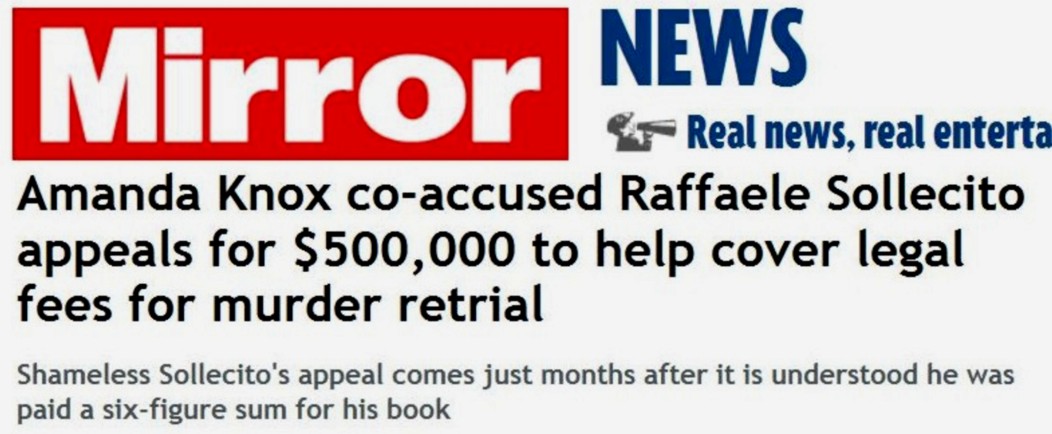
Back at trial in 2009 the defense lawyers had a fairly miserable time.
Strong prosecution case hard to dent, over-talkative client on the stand, weak defense rebuttals, and in the summations they were severely outclassed. And then of course they lost. They seemed sometimes bored, sometimes skeptical of their clients, and on several occasions one or two didnt even show up in court.
At the annulled appeal, things went a little better, after they got the judge they really wanted.
But there were embarrassing episodes in 2011, like the witness Aviello claiming that Giulia Bongiorno offered him and others some nice perks if they talked.
The Sollecito and Knox books dont paint the defense teams in an especially ethical light, though they are stated to have helped write the texts. They really should have scrutinised every word, but the mistakes in the book are so “barking mad” that we wonder if Ted Simon or Robert Barnett ever gave them the opportunity.
All four main lawyers have been named as “persons with significant information” in the contempt-of-court allegations being investigated. They will all be interrogated, may have to testify, and could find their law licenses on the line.
Those books will make their tasks at the Florence appeal way harder. There is much new ‘splaining to do.
Now the KnoxMellases say there will be a huge new financial burden on them, despite rumors of a huge blood-money book advance. Today Sollecito has his paw out for money online (see image below) though he was said to have received a big blood-money book advance as well. (Both books have sold miserably.)
It looks like the lawyers might have put in for a really big raise to stay on the case. The UK Mirror reports..
Shameless Raffaele Sollecito, the man accused of Meredith Kercher’s murder, has sparked fury after asking the public for a staggering $500,000 despite already cashing in on the British student’s death.
Just hours after the Mirror pictured the Italian student back in the arms of his former lover Amanda Knox, the 29-year-old set up an appeal to help cover his legal fees for the pair’s retrial.
Under the heading “Raffaele Sollecito ReTrial in Florence” he listed his page under the topic of “accidents & emergencies”.
His appeal comes just months after Sollecito is understood to have been paid a six-figure sum for his book “Honor Bound: My Journey to Hell and Back with Amanda Knox” about Meredith’s murder….
Sollecito’s countrymen were outraged after discovering his plea with many taking to his gofundme.com website page to express their disgust.
One Italian using the name Francesco said: “If there was a collection for you to end up in jail I would definitely be happy to participate.”
They added: “But today we see murderers sell their stories and make a pile of money. I’m sure Amanda has done.”
Another called Andrea Giani wrote: “I think you are guilty . . . are you not ashamed to ask for money from lawyers. I despise you very much,” while Marco Bolognesi added: “I’d really pay to see you in jail”....
Click on the image below for a larger version of Sollecito’s new (possibly illegal) blood-money attempt. The court or the taxman could remove much or all of what he gets.
Knox & Sollecito Meet - To Attempt To Bury The Hatchet Other Than In Each Other?
Posted by Peter Quennell
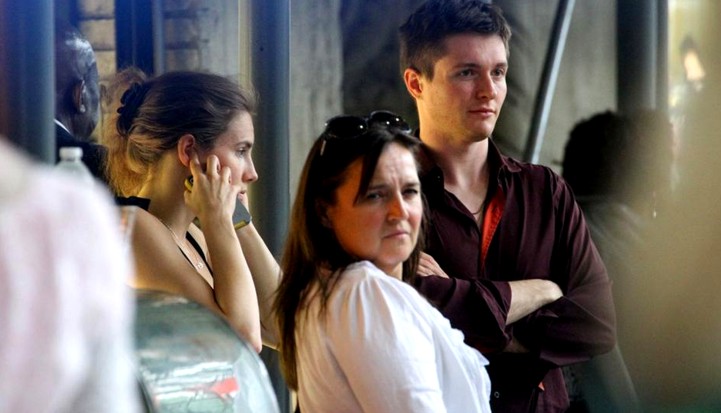
Knox and Sollecito meet in New York right after the release of Cassation’s ruling.
Below are excerpts from the report by Christopher Bucktin of the Daily Mirror. It is not tilted toward Knox and Sollecito, but it does get some of the law wrong in their favor.
What Cassation had just done was to toss out the corrupted 2011 Hellmann appeal, which was essentially THEIR first (automatic) appeal. Cassation was in effect saying they could run their own first appeal again in the appeal courts in Florence.
They can still choose not to. There was no retrial, and in fact one of Cassation’s major complaints about Hellmann was that he illegally tried to run a retrial rather than address the narrow grounds for appeal as the law requires.
Our exclusive pictures show how they secretly reunited just hours after judges ordered them to return to court [for their own appeal in Florence].
They didn’t seem to have a care in the world as they hugged and kissed during a secret meeting in New York.
But the passionate embrace between Amanda Knox and former lover Raffaele Sollecito raised some serious questions last night.
Their tryst came just hours after they were ordered to return to Italy to face a retrial over the murder of British student Meredith Kercher.
Italy’s top judges ruled the possibility that the 21-year-old died during a sex game that went wrong needed to be re-examined.
And the move immediately cast doubt on whether the couple should be allowed to be in contact now they have been formally recalled.
The pair, along with Knox’s mother, spent Tuesday visiting New York together ““ sparking rumours they have rekindled their romance.
There was no sign of James Terrano, the loyal boyfriend Knox is reportedly living with in Seattle, Washington.
An onlooker said: “They just looked like a normal couple who had been with each other a long time. Together with her mum they explored Manhattan and took the subway to get around.
“You only have to look at him to see he still holds a huge torch for Amanda. He clearly finds her captivating. When they hugged she closed her eyes as he gave her a tender kiss on her cheek.
“At one point he put his arm around her to help warm her up. They never once stopped chatting.
“It’s astonishing they are allowed to even talk to each other, let alone see one another, considering they are both suspects in a murder trial.”
The pair spoke to each other in Italian and were chaperoned during the afternoon excursion by Knox’s mother Edda Mellas, who walked several yards behind everywhere they went.
When confronted by the Mirror, Knox and Sollecito were cagey about their reunion.
Knox refused to comment about the Italian court’s ruling.
She also declined to confirm or deny reports that she planned to stay in the US and would not be returning to Italy to face justice.
Sollecito, who also says he has no wish to go back, said: “We have everything to do now. We have a lot of planning.”
Knox’s mother, Edda, added: “We need to speak to our lawyers.”
The couple were reunited as Italy’s Supreme Court “faulted” the 2011 acquittal of Knox and Sollecito by the appeals court for the murder and sexual assault of room-mate Meredith….
In a recent interview, in which she boasted about being proud of one-night stands and drug use, Knox defended her actions saying: “I think that everyone’s reaction to something horrible is different.”
The interview was given as Knox cashed in on the trial by promoting her book, Waiting To Be Heard.
The deal is reported to have earned her £2.6million. Sources close to 29-year-old Sollecito claim he still loves Knox and hopes they may get back together one day.
When in November 2011 he announced they had split he said tearfully: “Our love was like a seed that was not allowed to grow because it was brutally stamped on.
“We were both victims of a cruel injustice and our relationship was overcome.”
During the trial Sollecito, from Bari in southern Italy, claimed he was offered a secret deal by prosecutors to implicate the American undergraduate but said he never considered betraying her.
He added: “She told me that she thinks that I’m a kind of hero, but I don’t think so.
“I did it because I know it’s the truth. It’s the good thing to do. It’s the only way for me.”
Thursday, June 20, 2013
The Florence Palace Of Justice Where Sollecito And Knox Are Expected To Be Seen In Court Soon
Posted by Peter Quennell
This is a video of a recent light show. The soundtrack leaves something to be desired, but the huge new courthouse looks amazing at night.
We posted previously here on the new Palazzio di Giustizia, which is one of Europe’s largest and most modern. It only came into full operation this year.
It is reported today in UK newspapers that Knox and Sollecito have just been having a meeting in the vicinity of New York, maybe to sort out a common narrative once and for all. Our betting is that each will appear in the Florence court, not least to keep a close eye on the other and to attempt to warm the judges to themselves.
However, their nasty and dishonest books have not made things any easier for them, and have led to a lot of negative reaction in Italy where they have been discussed on TV. It is easy to spot where in many places the two texts conflict, and also where (as demonstrated in the two post below) they also contradict many accepted well-documented facts of the case.
Both books are being considered as substantial new evidence, and the prosecution will ask the appeal court if they can be included in.
Both books are also being investigated, by the chief prosecutors in Florence and Bergamo for separate new felony charges, as they appear to constitute substantial lllegal attempts along with the internet vilification posted by the likes of Preston, Fischer and the Moores, to inflame and mislead public opinion during an ongoing legal process.
The writers have also sought to undermine the officers of the court, by accusing them of serious crimes, again as illustrated in the two posts directly below. Many Italians and Americans with “relevant information” could be called to testify for the prosecution or the defenses. They will probably be asked to explain their own inflammatory campaigns and may face charges of their own. Again, Preston, Fischer and the Moores seem to have painted targets on their backs.
Results of both investigations, together with any new charges against Sollecito, Knox, and their entourages, should be made public well before the new appeal of Meredith’s case gets under way.
If the two are indicted on new charges for the books, as expected, that will mean more to explain, more to try to harmonize upon, more goodwill lost, and more legal bills.
If their Italian lawyers recklessly promoted these daft projects, as texts in the books themselves suggest, the lawyers could all face both contempt of court charges and malpractice suits from their clients.
Nice work….

